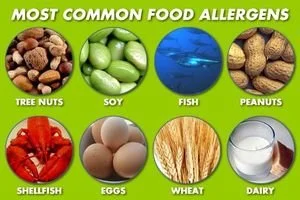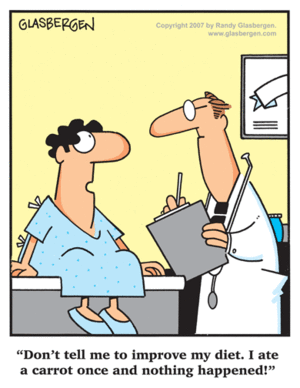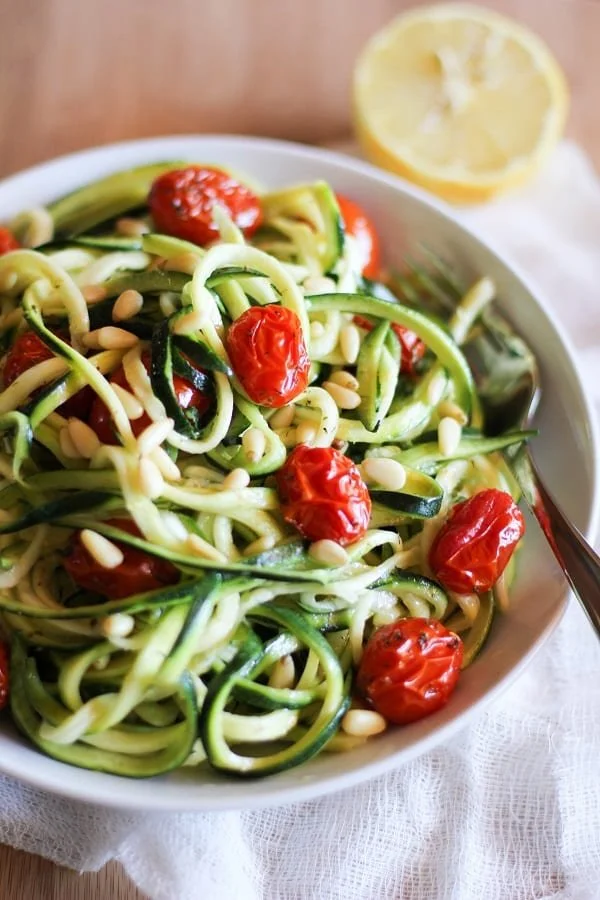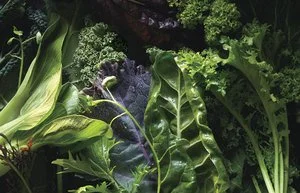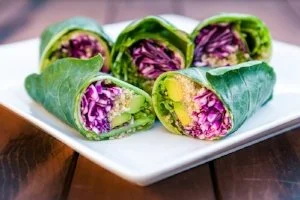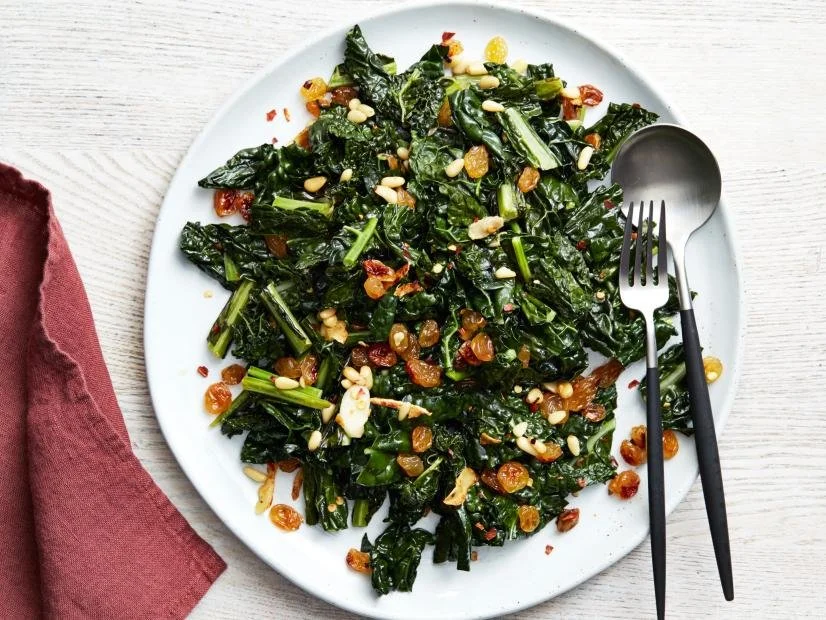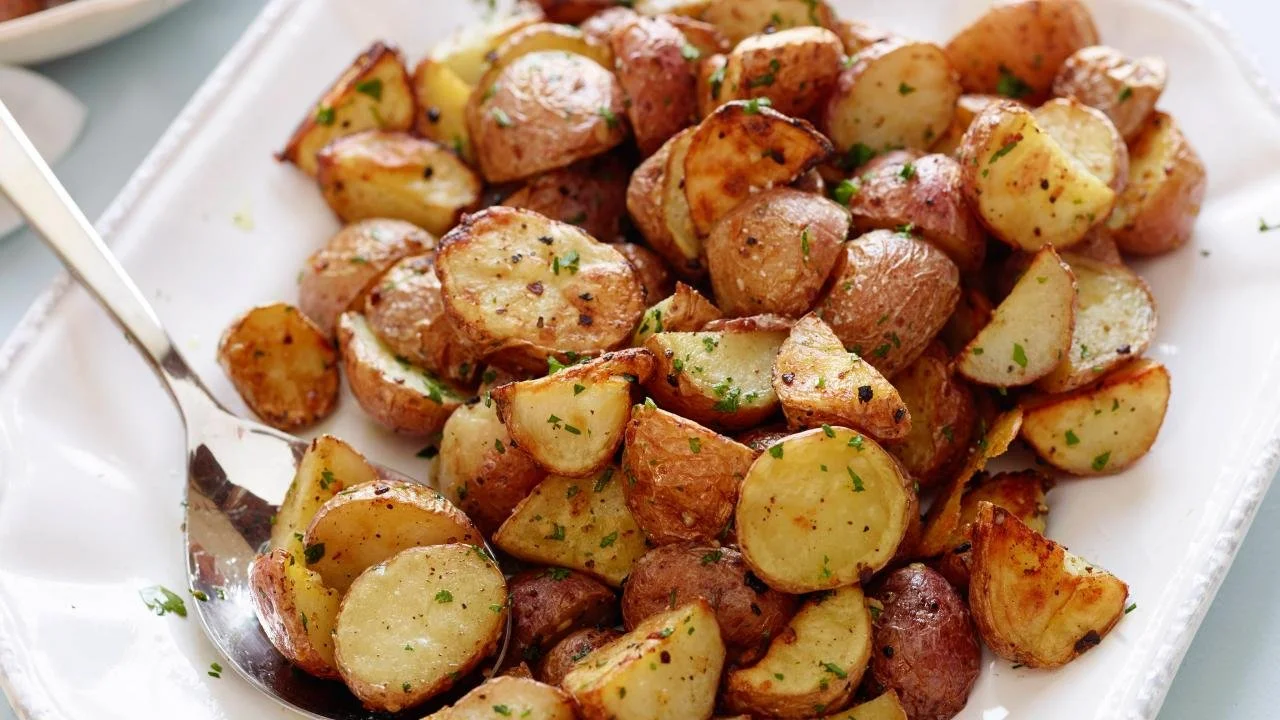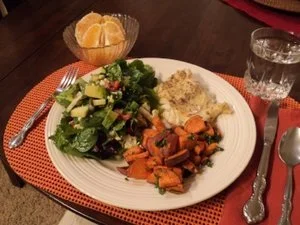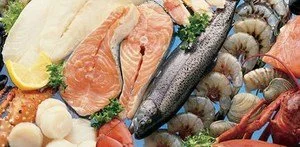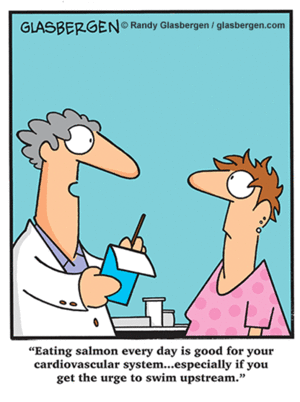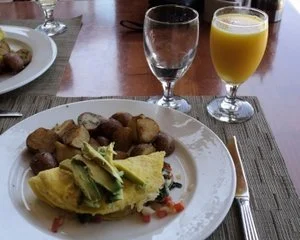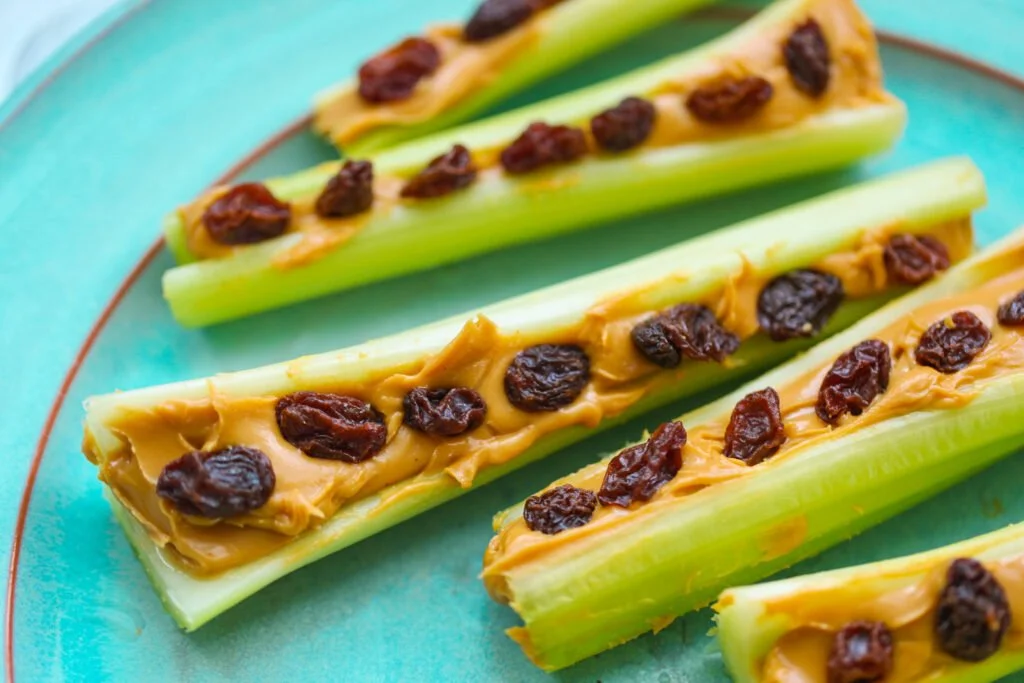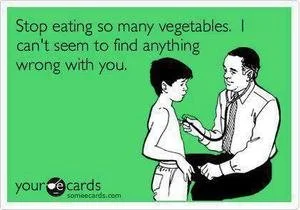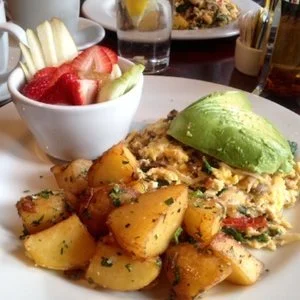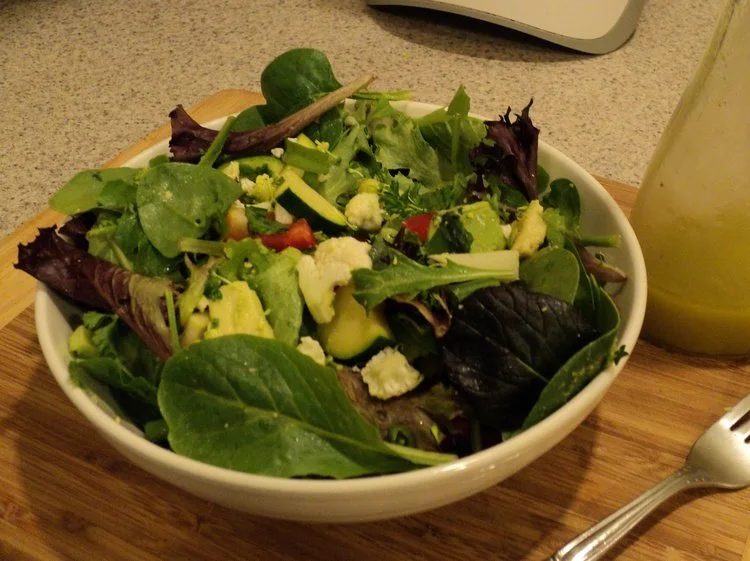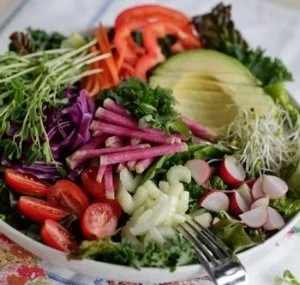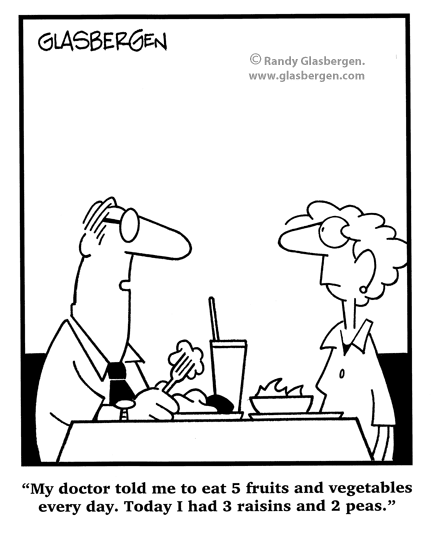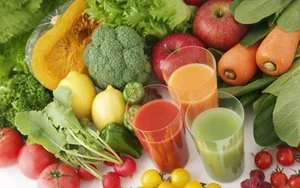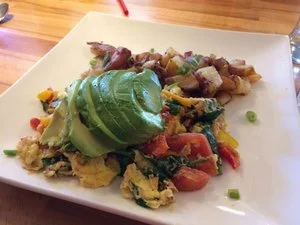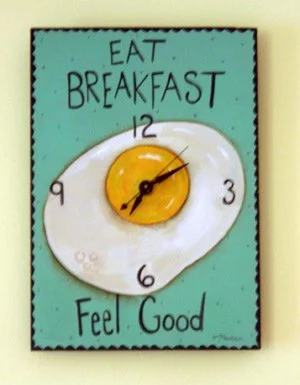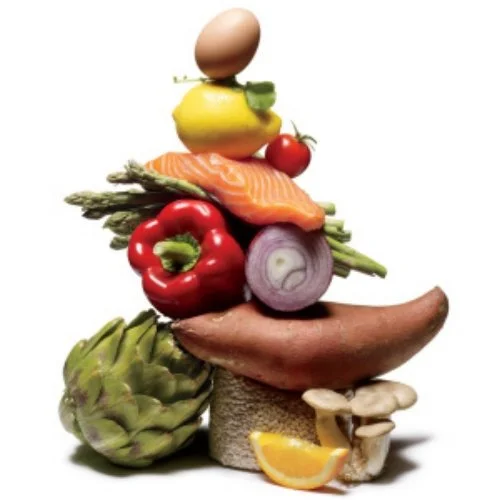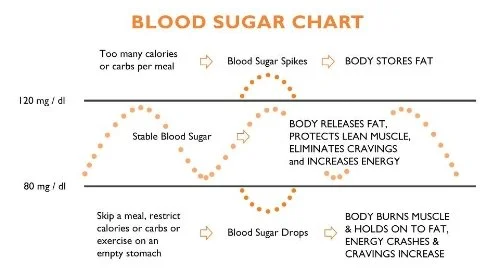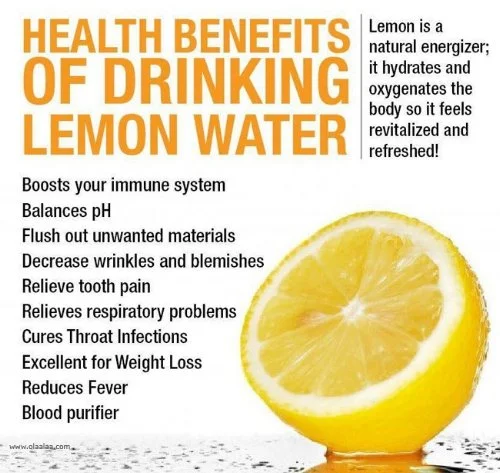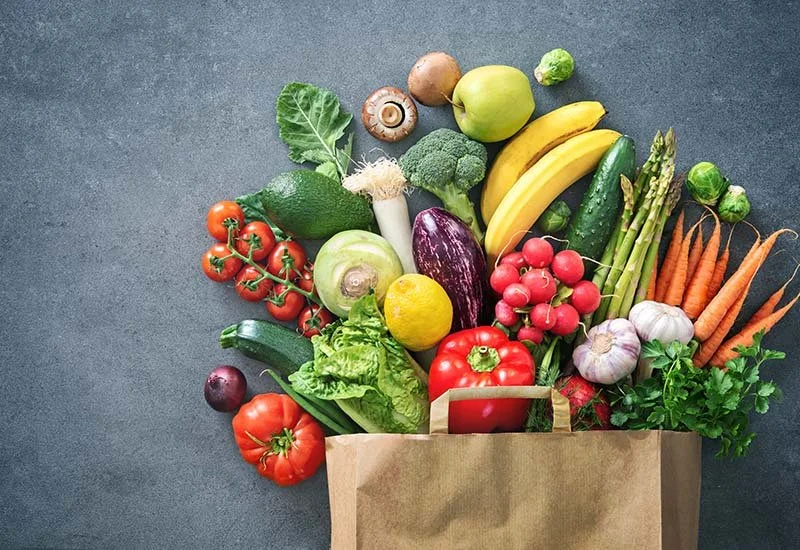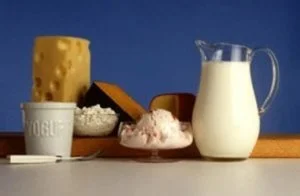Day 23
23 DAYS TO A HEALTHIER YOU - Day 23
Cleanse Day 14
Today we take a look at what comes next as you make a conscious decision about letting any of the “nutritional bandits” back into your diet and how personal care products and stress contribute toxins to our everyday lives as well.
Today’s Topic: What’s Next?
"Perfection is boring. Consistency doesn't mean you have to be rigid. Imagine yourself traveling on a gorgeous, healthy highway. It's okay to take detours from time to time, to check out scenic roads and chocolate. Just be really honest with yourself, and don't make detours a regular habit."
~ KRIS CARR, CRAZY SEXY WELLNESS
So, what's next? As we end the Nutritional Cleanse Program, YOU get to CONSCIOUSLY decide, from this non-addicted state, how many of the "nutritional bandits" you will allow back into your life. Let's review what they are again:
Unfiltered tap water
Alcohol
Caffeine / Chocolate
Sugar
Refined & processed foods
Gluten
Dairy
Red meat / Pork
Unhealthy fats / fried foods
Chemical Stressors
Common sense should tell you that you cannot reasonably expect to make major improvements in your health with just two weeks of clean eating and then returning to what you were doing before. At this point, you probably have an idea of how the above foods affected your energy, sleep, mood, skin, hair, joints, and digestive tract. You also may have learned how your diet played into your disease, medical condition, or hard-to-define collection of symptoms.
Hopefully, you will continue with drinking pure water, eating organic, and staying away from most processed and refined foods and unhealthy fats from now on. IF you do choose to consume any of the other "nutritional bandits" going forward, do it CONSCIOUSLY, choose EXCELLENT quality that is ORGANIC (and locally produced if possible), keep the portions SMALL, and then ENJOY IT!!!
If you are in good health and at the weight you are comfortable with, I usually suggest a 80/20 approach = 80% “clean” foods and 20% GOOD QUALITY “treats”. If you have 3 meals and 2 snacks a day that would mean 7-8 times a week you could allow yourself a “treat” and still MAINTAIN good health. However, just remember that EVERY cup of coffee or glass of wine falls into the “treat” category (as well desserts, bread, pasta, dairy, etc), so if you have a 1 cup of coffee every day for example, that would be your “treat” quota for the whole week!!!
And, while we are on the subject of coffee, let me just say that it has been my experience and that of everyone I know, that when coffee is allowed back on a regular basis, it becomes really challenging to maintain other healthy choices. Coffee is SO acid forming to the body, addictive, and such a low vibrational substance that, when you start the day with it, you choices tend to go "down" afterward rather than "up". The same goes for regularly consuming alcohol, sugar, gluten, and dairy. So, here’s something to consider:
"Anything that you would experience significant withdrawal symptoms from, should they be center stage in your diet?"
~ KRIS CARR
IF your goal is to heal a health condition and/or continue to lose weight I suggest a 90/10 approach, limiting your “treats” to 3-4 times a week or LESS - in between doing seasonal cleanses regularly. Personally, I choose to eat this way 90% of the time as a "lifestyle". I do this by not allowing these things to “live” in my house and indulging ONLY when I go out or on special occasions. No matter how much I know or how long I have been studying nutrition, if I allow these “nutritional bandits” into my house, they end up in my mouth!!!
"Once the body heals deeply, and a strong immune system is in place, I find that people can eat some of their former meals and drinks without problems. They just can't do it all the time."
SCOTT OHLGREN, THE NEW 28 DAY CLEANSING PROGRAM
Additional Information
In addition to diet, personal care products and stress are a couple of other areas that are a major source of toxins (and acidity), and are a good idea to take a look at and make some changes now as you go forward.
The Environmental Working Group (EWG) states that the average person uses approximately 10-15 personal care products with 26 different ingredients every day. The skin is our largest organ and, with it's porous surface, it takes only 26 seconds for those toxins to enter our bloodstream and begin circulating throughout our body.
HERE IS A LINK FOR MORE INFO:
ARE YOUR PERSONAL CARE PRODUCTS TOXIC?
Stress is the accumulation of normal and abnormal pressures of daily living that test the individual's ability to cope. Chronic stress - real or perceived, physical, emotional, or environmental - takes a tremendous toll on the body, mind, and spirit, and is a major cause of disease and even death. When the body's stress response is always on, the constant surge of chemicals and the increase in heart rate and blood pressure causes the stress to become "toxic" in both the brain and the body.
HERE IS A LINK TO MORE INFO:
Check-in: Congratulations!!!
Not only have you given your body a break from the “nutritional bandits” that rob you of good health when consumed on a regular basis, you have also supported your body with REAL WHOLE FOOD! And you’ve learned how to eat a healthier diet going forward. GOOD FOR YOU!!!
TODAY’S AFFIRMATION: I NATURALLY MAKE CHOICES THAT ARE GOOD FOR ME. I TAKE LOVING CARE OF MY BODY AND IT RESPONDS WITH HEALTH, AN ABUNDANCE OF ENERGY, AND A WONDERFUL FEELING OF WELL-BEING!
Thank you so much for your participation in the 23 DAYS TO A HEALTHIER YOU Nutritional Cleanse program. I hope that you enjoyed it and found value in what you learned and the progress you made. You will continue to have access to all the program content in the future to revisit as you desire.
GOOD FOR YOU for making this HUGE investment in your health and CONGRATULATIONS!!!
Happy, Healthy Living!
Much love and many blessings,
JoAnn
Day 22
23 DAYS TO A HEALTHIER YOU - Day 22
Cleanse Day 13
Today we take a look at food allergies and sensitivities and how you can “listen” to your body’s reactions as you begin to think about reintroducing some of the “nutritional bandits” into your diet when this program is over.
Today's Topic: Food Allergies & Sensitivites
As you begin to think about ending your cleanse, you may want to consider testing for food sensitivities.
Food allergies or sensitivities are an anti-body response to a certain food. It’s speculated that 90% of the population have food sensitivities that are genetic. Most of these lie hidden or dormant until other stress burdens trigger a response.
A food “allergy” response can cause sweating, flushing, increased mucus production, diarrhea, nausea or vomiting – so it’s clear in a short period of time that it doesn’t agree with you.
Food “sensitivities” or “intolerance” can be triggered on a much less severe scale by foods that you’ve become sensitized to over the years (this often happens when you eat the same foods over and over). A food sensitivity is an enzyme deficiency to digest a certain food or additive. This type of sensitivity is unfortunately the fastest growing allergy group as people are more and longer exposed to chemically altered, genetically modified, enzyme depleted, processed foods that the human body is not equipped to handle. When the body consumes these foods, a series of events occur that eventually creates a auto-immune response causing inflammation & bloating, and ultimately weakening the immune system.
The 8 most common food allergies/sensitivities are to DAIRY, GLUTEN, EGGS, SOY, PEANUTS, TREE NUTS, FISH & SHELLFISH. Also common are SUGAR, YEAST, MUSHROOMS, COFFEE, & CORN.
There is a simple saliva lab test that can determine if you are “intolerant” to dairy, gluten, eggs or soy or more expansive tests to look at more foods and other substances as well.
You can also do a “challenge” test on your own. After COMPLETELY avoiding a food for 2 weeks (which hopefully you have done as part of the cleanse program), eat a meal of that food and nothing else. Take your pulse before eating it and then every half hour for a couple of hours afterward. If your pulse changes more than 10 beats, you probably have an “intolerance” to that food.
I highly recommend paying attention as you begin to SLOWLY reintroduce any foods you have been avoiding ONE AT A TIME to see how your body responds. Please note that it can take a couple of days for symptoms to show up, so try to introduce only 1 food every few days to get a clear picture of what you might be reacting to.
Your signal system is MUCH clearer now and you should be able to “hear” its messages loud and clear. For example, I do okay with small amounts of milk or goat cheese, but cheddar, Swiss, blue cheese, etc. all give me a lot of mucous and stuffy nose (even though I don't test as having an intolerance). Gluten and sugar both make me tired, inflamed, and constipated if I eat too much. (Again, this is NOT due to an intolerance - it's what those "foods" do to everyone, but I've just become so aware of it from doing the cleanse program so many times.) Coffee, although I LOVE it, makes me feel terribly acidic and tends to be my "gateway drug" to craving more acid forming foods. And WHENEVER I eat chocolate I get heartburn! So pay attention to what your body tells you going forward.
HERE’S A LINK TO ASSIST YOU WITH THIS:
Check-in: How are you doing?
Today I want to share this link to an article written about The 5 Levels of Eating developed by my dear friend and nutrition mentor, Dr. Ed Bauman, who is the founder and director of my alma mater, Bauman College of Holistic Nutrition, and creator of Eating for Health which this Nutritional Cleanse Program is largely based upon. I invite you to look for the level you were at before the program started, the level where you are now, and the level you want to choose as you go forward:
TODAY’S AFFIRMATION: I AM RADIANT WITH LIFE, FILLED WITH ENERGY TO ACCOMPLISH ALL THAT I DESIRE TO DO AND BE!
Tomorrow we’ll take a look at what comes next as you make a conscious decision about letting any of the “nutritional bandits” back into your diet.
Feel free to email me or post a comment below to ask questions or share your thoughts and experiences ~ I’d love to hear from you!
Blessings, JoAnn
Day 21
23 DAYS TO A HEALTHIER YOU - Day 21
Cleanse Day 12
Today we take a look at including even MORE vegetables in our healthy diet along with some great recipes.
Today's Topic: MORE Vegetables!
When in doubt…EAT MORE VEGETABLES!!! Maybe you have noticed that most of the recipes I’ve shared with you contain them. And for good reason.
Eating more vegetables is one of the simplest choices you can make to improve your overall health. In fact, the goal is to eat at least 1 pound of vegetables every day!
Vegetables are a great source of nutrients (vitamins and minerals) that make you FEEL healthy and energized and are vital for the healthy maintenance of our bodies. They also contain fiber that helps provide a feeling of fullness, stabilizes blood sugar, and keeps our digestive systems happy.
In particular, the minerals that vegetables contain are super important! One of my nutrition teachers said that every dis-ease of the body is caused from lack of minerals – which makes sense because minerals alkalize the body!
So add them in whenever and wherever you can, and remember to eat a variety of types and colors, raw and cooked, to give your body the mix of nutrients that it needs.
Recipes
(Click on the photos below to view recipes.)
Check-in: How are you doing?
Can you believe how much information we have covered and how far we have come in just 21 days? It blows my mind every time I do this program! I am so excited to be a part of folks realizing how well the body can function when we simply give it the fuel it needs – CLEAN REAL FOOD!
TODAY’S AFFIRMATION: I AM WHOLE, PERFECT, STRONG, POWERFUL, LOVING, HARMONIOUS, AND HAPPY!
Tomorrow we’ll take a look at food allergies and sensitivities and how you can “listen” to your body’s reactions as you begin to think about reintroducing some of the “nutritional bandits” into your diet when the cleanse is over. I’ll also be including a daily food diary PDF to assist you with that process.
Feel free to email me or post a comment below to ask questions or share your thoughts and experiences ~ I’d love to hear from you!
Blessings, JoAnn
Day 20
23 DAYS TO A HEALTHIER YOU - Day 20
Cleanse Day 11
Today we take a look at including dark leafy greens in our healthy diet along with some great recipes.
Today’s Topic: Dark Leafy Greens
"Dark leafy green vegetables have chlorophyll, a detoxifying agent that helps clear the skin, cleanse the kidneys, and cleanse and build the blood. Eating any chlorophyll-rich food will help boost immunity, treat illness, and rid the body of unwanted substances."
~ FOOD MATTERS
Dark leafy greens include Arugula, Bok Choy, Broccolini, Collard Greens, Dandelion Greens, Kale, Mustard Greens, Romaine Lettuce, Spinach, and more. They are nutritional powerhouses, having probably the most concentrated source of nutrition of ANY food, and are a REALLY important component to a healthy diet. In fact, Ed Bauman, M.Ed., Ph.D. (founder & director of my alma mater, Bauman College of Holistic Nutrition) even goes so far as to give it its own food group!
When deciding how to prepare a dark green vegetable, try a small bite of it raw after you wash it. If it’s tender and mild or just a little bit spicy (such as lettuce or arugula), add it raw to a salad. If the vegetable is tender and extra spicy (such as mustard and dandelion greens) or tough (such as collards and kale), consider blanching, stir-frying or sautéing it. Once it’s cooked, you can use it in a multitude of ways.
Rarely a day goes by that I don’t have some dark leafy greens. I use them in smoothies, salads, green drinks, egg scrambles, and soups and stews – all staples in my regular diet. And I believe they are the most significant factor in alkalizing our bodies and eliminating cravings!
HERE’S A LINK TO A GREAT ARTICLE FOR MORE INFORMATION:
Recipes
(Click on the photos below to view recipes.)
Check-in: How are you doing?
Here’s a photo of a delicious “e-cleanse friendly” Autumn dinner from a few years ago - Lemon Rosemary Chicken Tenders, Quinoa (cooked in chicken broth) with fresh parsley, roasted asparagus, beets, cauliflower, and Brussels sprouts, and sungold tomatoes. It was feast!
I know we have talked about weight loss and that looks and feels really good! :) AND I invite you to take a personal inventory to check out other benefits you might also be experiencing from doing the cleanse program. Have you noticed improved skin tone and appearance? Do you feel calmer and clearer mentally and emotionally? Do you notice less digestive discomfort, bloating, and gas? AND, most importantly, are you learning how to eat for health???
"You'll see a change not only in the way you look but in the way you work your job, the way you see your surroundings, and the way you love the people in your life, including yourself." ~ Deepak Chopra, M.D.
TODAY’S AFFIRMATION: I AM NOW EXPERIENCING HEALTH AND WELL-BEING IN MY LIFE. I AM HEALTHY, RADIANT, AND FREE!
Tomorrow we'll look at including even MORE vegetables in our healthy diet!
Feel free to email me or post a comment below to ask questions or share your thoughts and experiences ~ I’d love to hear from you!
Blessings, JoAnn
Day 19
23 DAYS TO A HEALTHIER YOU - Day 19
Cleanse Day 10
Today we take a look at including starchy vegetables in our healthy diet along with some great recipes.
Today’s Topic: Starchy Vegetables
"Starchy vegetables are high-quality carbs that contain valuable nutrients, but they're more calorie-dense than non-starchy, water-rich varieties, so be sure to eat them in moderation."
~ JOY BAUER
A lot of people are under the impression that starchy carbohydrates are "bad" for us. First of all, I am of the opinion that ALL real, whole food (the way nature made it!) is "good" for us. And, while there was a time when starchy vegetables were given a "bad rap" and thought to contribute to blood sugar issues and weight gain, research has shown that is absolutely not true...but quite the opposite. They are an important part of a healthy, balanced diet when chosen correctly and consumed in reasonable portions.
Starchy vegetables include corn, potatoes, acorn squash, butternut squash, spaghetti squash, pumpkin, winter squash, sweet potatoes and yams, parsnips, and peas. These veggies contain concentrated carbohydrates, a variety of valuable nutrients, and lots of fiber that takes longer to digest - making them not only nutritious, but an important source of energy that keeps you satisfied.
And if you are having cravings for something sweet and/or comfort food, a serving of some good starch will often fill the bill. They help to raise serotonin levels ("feel good" brain chemicals) which helps to regulate our mood, behavior, and memory, and will often be the deciding factor is being able to stay on a healthy eating program.
However, ALL starches turn into "sugar" in the body. While these are good and necessary foods to fuel both the brain and the body, too much (which is what we tend to do with these foods) is NOT good. That’s why we limit them to only one small section on our imaginary picnic plate (or the size of the palm of your hand,) why we eat WHOLE forms of them, and BALANCE them with adequate protein and non-starchy veggies.
Recipes
(Click on the photos below to view recipes.)
Check-in: How are you doing?
Some people get disappointed that they are not losing weight faster. Remember that everyone doesn’t start from the same place. Someone who hasn’t eaten healthy in the past is going to see more radical results than a person who eats fairly healthy regularly. Also, the fiber in the cleanse kits absorb water and slows down the weight loss process. However, it is doing other GOOD work and, once it is out of your system, you will probably see things shift. Be sure that you are eating enough food so your body doesn’t go into “starvation mode,” and that you are eating BALANCED meals and snacks to keep your blood sugar levels happy so you remain in the fat losing mode rather than the fat storing mode.
Keep up drinking plenty of water and eating healthy balanced meals with adequate protein. Even though the major detox symptoms are behind us now, the body is still doing BIG work inside. If you are craving sugar, make sure you are getting enough protein, and then try a small amount of fruit. If you are craving dairy, avocado or nuts & seeds are a good substitute. And if you are craving “comfort” carbohydrates, try some of the food mentioned in today’s information as long as it’s part of a balanced meal.
Hope you can see how this program is both “cleansing” and “building health” at the same time - which is SUCH a great thing! We’re on the home stretch now...
TODAY’S AFFIRMATION: MY BODY IS A TEMPLE. I CARE FOR MY BODY WITH LOVE AND ATTENTION!
Tomorrow we’ll look at including dark leafy greens in our healthy diet.
And feel free to email me to ask questions or share your thoughts and experiences ~ I’d love to hear from you!
Blessings, JoAnn
Day 18
23 DAYS TO A HEALTHIER YOU - Day 18
Cleanse Day 9
Today we take a look at adding fish and seafood into our healthy diet along with some great recipes.
Today’s Topic: Seafood
Seafood is a great choice for protein in your diet! It's delicious, with exceptional nutritional value, and can be served in a variety of ways.
Fish is the best source of Omega-3 essential fatty acids (EFA's) that are essential for optimal health, but because they are not made by the body, they must be obtained from foods. However, as the levels of pollution in our waters has increased, there is some cause for concern now. Fortunately, the fish that suffer the least amount of toxic contamination are some of the best sources of good fat and nutrients. Here’s a chart that I find helpful in choosing seafood:
Personally, I purchase most of my seafood at Whole Foods Market because it’s probably the safest. Their staff is well informed and can answer your questions. Most of the time you hear about how bad farmed fish is and not to buy it, but Whole Foods is just one of the places that are now responsibly farming fish without antibiotics, pesticides in the water or feed, algaecides on the nets, and never genetically engineered - so -between their wild-caught seafood and responsibly farmed seafood, you can purchase good quality fish year round.
FOR MORE INFORMATION, VISIT:
Recipes
(Click on the photos below to view recipes.)
Check-in: How are you doing?
The better you follow the program the better your results will be, but I am all too aware of how challenging it can be to eat healthy all the time especially with our busy lives. Remember that it isn’t about being perfect, but about increasing awareness, moving in a more positive direction, and knowing that EVERY improvement makes a difference! As we become more and more conscious about eating healthy we can begin to find ways to support ourselves in making better choices.
Here's a sample of a daily food "plan":
Breakfast: Veggie Omelet (with avocado instead of cheese), potatoes (too many so I took 1/2 of them home), and fresh orange juice
Lunch: Detox Salad with Quinoa, Avocado, & Apple, with added chicken.
Snack: Beet Grapefruit Green Juice
Dinner: leftovers - Paleo Shrimp Scampi: Prawns (protein), Spaghetti Squash (starch), Garlic & Olive Oil Sauteed Green Beans, and fresh berries.
TODAY’S AFFIRMATION: WELL-BEING IS MY NATURAL STATE OF BEING!
Tomorrow we’ll look at including starchy vegetables in our healthy diet.
Feel free to email me or post a comment below to ask questions or share your thoughts and experiences ~ I’d love to hear from you!
Blessings, JoAnn
Day 17
23 DAYS TO A HEALTHIER YOU - Day 17
Cleanse Day 8
Today we take a look at snacks and some delicious desserts for our healthy diet.
Today's Topic: Healthy Snacks
Healthy, balanced snacks are a really important component of a healthy diet for those times in between meals when you want or need something to tide you over.
The thing to remember is to include some protein, healthy fat, and carbohydrates in your snacks for balanced nutrition and to keep your blood sugar happy, and not just consume some form of sugar (even fruit sugar) or things that turn into sugar (grains & starches).
EXAMPLES:
RAW fruit & RAW nuts or seeds
Veggies with hummus or guacamole
Hard boiled eggs
Trail mixes are okay IF they have RAW nuts & NO SUGAR in them.
Carrots, celery, or apple slices with raw almond butter.
DESSERTS
I am a BIG fan of sweets and I am going to have them one way or another - this much I know about myself. So, while I often turn to fresh fruit for that sweet taste, I also choose to treat myself to a healthy "dessert" treat sometimes as well. Just remember that they are high "sugar" and high fat, so don't get carried away!
(The raw desserts listed below are quick and easy to make. If you don't have a food processor, keep an eye out at the thrift stores. I found mine for $15.)
Recipes
(Click on the photos below to view recipes.)
Check-in: How are you doing?
Congratulations! We have completed one full week on our cleanse! Yippee, yippee, yahoo!!! I can always FEEL the difference when my body is more alkaline. Feels good…feels “clean”. Celebrate and do something extra special for yourself!
Here's a sample of a daily food "plan":
Breakfast: Healthy Smoothie
Lunch: Super Energy Kale Soup, hard boiled eggs, and grapes
Snack: Veggies & hummus
Dinner: Paleo Shrimp Scampi: Prawns (protein), Spaghetti Squash (starch), Garlic & Olive Oil Sauteed Green Beans, and Dandelion Tea Caffe Latte for dessert
TODAY’S AFFIRMATION: I SEE MYSELF HEALTHY AND WHOLE!
Tomorrow we’ll look at including fish and seafood in our healthy diet.
Feel free to email me or post a comment below to ask questions or share your thoughts and experiences ~ I’d love to hear from you!
Blessings, JoAnn
Day 16
23 DAYS TO A HEALTHIER YOU - Day 16
Cleanse Day 7
Today we take a look at the role of gluten-free whole grains in our healthy diet along with some great recipes.
Today’s Topic: Grains
When I refer to non-gluten UNREFINED WHOLE GRAINS, I am talking about grains in their whole, natural state. Brown rice, wild rice, millet, quinoa, buckwheat and amaranth are all alkalizing or neutral whole grains and can be eaten in their whole form.
A lot of people are choosing to not eat grains at all these days. If you are dealing with any health conditions, you may want to keep all grains out - even the good ones. But if you are feeling good and find that your body tolerates them, I invite you to explore some of these delicious grains and blends – many are available in bulk bins at your local health food store. (It's important to make sure your grains are fresh to avoid mold.)
My favorite is Lundberg’s Wild rice blend. I love to add a little olive oil, LOTS of fresh chopped parsley, salt & pepper and sometimes a squeeze of fresh lemon juice. YUM! And if you are not a fan of the heavier rices, know that white basmati rice is a whole grain rice (has not had the outer shell removed) and is closer in texture and flavor to regular white rice.
While corn meal and gluten-free oats are considered non-gluten grains, they are also more acid forming in the body, so I suggest only minimal consumption of them during our cleanse ~ if at all.
I confess that I had resisted trying quinoa until I started leading these cleanses, and now I love it. I find it sweet and comforting which is what I’ve always liked about wheat. Plus it’s has the highest protein content of any grain and also is the ONLY grain to have ALL 8 essential amino acids present in it so it is a COMPLETE protein all by itself. I encourage you to give it a try!
Recipes
(Click on the photos below to view recipes.)
Check-in: How are you doing?
Here's a sample of a daily food "plan":
Breakfast: Healthy Smoothie
Lunch: JoAnn's Mineral Rich Soup with prawns, and grapes
Snack: Ants on a Log - celery with almond butter and raisins
Dinner: leftovers - Roast chicken (protein), wild & brown rice mix with fresh parsley (starch), Favorite Salad combo with lemon & olive oil dressing, and fresh mango
TODAY’S AFFIRMATION: I AM ACCEPTING HEALTH IN MY BEING!
Tomorrow we’ll celebrate one week on the cleanse and take a look at snacks and some delicious desserts for our healthy diet.
Feel free to email me or post a comment below to ask questions or share your thoughts and experiences ~ I’d love to hear from you!
Blessings, JoAnn
Day 15
23 DAYS TO A HEALTHIER YOU - Day 15
Cleanse Day 6
Today we explore eating cooked vegetables in our healthy diet along with some EASY recipes.
Today’s Topic: Cooked Vegetables
"When we heat, soften, and moisturize the vegetables and beans we dramatically increase the potential digestibility and absorption of many beneficial and nutritious compounds. We also increase the plant proteins in the diet, especially important for those eating a plant-based diet with limited or no animal products."
~ DR. FUHRMAN
COOKED veggies are next on our list of foods to include in our healthy diet. Did you know that some nutrients are more available when food is raw and others are more available when food is cooked?
While the most important thing is to eat a variety of vegetables prepared in a variety of ways, sometimes cooked vegetables are better than raw. Some nutrients found in vegetables (such as water-soluble vitamins and enzymes) may be depleted during cooking, but levels of some other nutrients may be increased. Cooking vegetables can make the cell walls less rigid, which makes it easier to absorb certain nutrients and digest food better.
Your local produce section, produce stand, or farmer’s market has an abundance of delicious and nutritious vegetables to steam, sauté, bake, broil or grill. I find that I like them prepared pretty simply so that their natural flavor comes through. People often say what a great cook I am. But I really just make simple food with EXCELLENT ingredients and it makes a HUGE difference!
FRESH ORGANIC VEGGIES ARE SO DELICIOUS!!!
Recipes
(Click on the photos below to view recipes.)
Check-in: How are you doing?
By this point in the program, I’m usually feeling really good – body, mind, & spirit! Remembering to do my daily yoga, exercise, dry skin brushing, shower, water, and supplements - and starting to get to the point AGAIN where I ask myself why I EVER go off of this program cause I just feel so good doing it!
Here's a sample of a daily food "plan":
Breakfast: Healthy Smoothie
Lunch: Veggie Scramble, Potatoes, & Fruit cup
Snack: Pear-fect Green Juice
Dinner: Roast chicken (protein), wild & brown rice mix with fresh parsley (starch), Favorite Salad combo with lemon & olive oil dressing, and fresh strawberries
Please note that I change up the ingredients in my smoothies for variety and greater nutrition. Also, while I eat animal protein almost every day, I strive for at least 1-2 meals each day that are vegetarian. Better for me, better for the planet, and variety is KEY!
TODAY’S AFFIRMATION: I AM LETTING MY BODY HEAL ITSELF!
Tomorrow we’ll look at the role that gluten-free whole grains can play in our healthy diet.
Feel free to email me or post a comment below to ask questions or share your thoughts and experiences ~ I’d love to hear from you!
Blessings, JoAnn
Day 14
23 DAYS TO A HEALTHIER YOU - Day 14
Cleanse Day 5
Today we take a look at the role that homemade soups and stews can play in our healthy diet along with some GREAT recipes.
Today’s Topic: Soups & Stews
Soups and stews take many of the healthiest ingredients possible and put them together in one pot. They usually involve blending the vegetables or at least chopping them into bite size pieces. This makes them easy to digest so your body can absorb and utilize all of the nutrients more easily...a delicious way to get a cleansing dose of vitamins and minerals.
Soups and stews are a great way to get more vegetables in our diet - and the nutrients they provide. Even leafy greens such as kale and spinach can be added to soup. And vegetables can be pureed and added to soup to create a creamier version without the addition of extra fat.
Another thing is that soups and stews retain the nutrients (vitamins & minerals) of the cooked vegetables since you don’t dispose of the water. Instead the vitamin packed water becomes part of the broth in the soup.
Soups and stews are a low-fat and high fiber meal option, so are both filling and low-calorie. (Please note that recipes with coconut milk added increase the fat content and so, since we are focusing on low-fat for our cleanse, take it easy with those.
People tell me over and over that they are too busy to prepare food to eat healthy. Or that it’s a challenge to cook for just one person. I’m single and lead a extremely busy life and the KEY THAT I have found is to prepare a variety of soups and stews (usually 2-3 times a week all year round) and freeze them in individual serving containers. That way, when I’m in a hurry, on the go, or just too tired to cook, I always have a selection of something delicious and healthy to eat instead of choosing something that isn’t good for me.
It’s kind of a ritual for me to come home from grocery shopping, wash my beautiful produce, and make a pot or two of soup right then and there. Try it – you’ll be glad you did!
(I’ve already shared my blog about Chicken Soup on Day 7, but you can click on the link in the recipe section below if you’d like to read it again.)
Recipes
(Click on the photos below to view recipes.)
Check-in: How are you doing?
Remember that each meal should include a small portion of protein, a small portion of starch, a larger portion of vegetables and fruit, and 1-2 servings of good fat. If the recipes you choose don’t already provide all of those components, you need to adjust your meal accordingly.
I have a smoothie for breakfast and soup for lunch a lot of the time. They are both quick and easy to digest on days that I see massage clients or have a busy schedule. You see, in order to properly digest your food well, your body needs to be in the "relaxation" mode. So when I am physically working hard or on the run, I choose to take it easy on my digestion and save the harder to digest foods for when I'm more relaxed.
Here's a sample of a daily food "plan":
Breakfast: Healthy Smoothie
Lunch: Vegetable Pea Soup, and an orange
Snack: Liver Detox Juice
Dinner: Lamb Salad (at East West Cafe in Sebastopol) - lamb (protein), quinoa (starch), greens, onion, tomato, cucumber, carrots, and tahini lemon dressing, and fresh blueberries for dessert.
Hopefully, you are seeing a theme of a small amount of protein, a small amount of starch, and then lots of veggies and a small amount of fruit to balance the meal. Remember the sections on the picnic plate?
TODAY’S AFFIRMATION: I AM LEARNING ABOUT HEALTHY ACTIVITIES THAT I’D LIKE TO BE A PART OF!
Tomorrow we’ll explore eating cooked veggies as part of our healthy diet.
Feel free to email me or post a comment below to ask questions or share your thoughts and experiences ~ I’d love to hear from you!
Blessings, JoAnn
Day 13
23 DAYS TO A HEALTHIER YOU - Day 13
Cleanse Day 4
Today we take a look at the importance of consuming salads as part of our healthy diet along with some GREAT recipes.
Today’s Topic: Salads
A salad a day REALLY keeps the doctor away!!! Allowing yourself to become “addicted” to salad is one of the best steps you can take for a healthy diet and especially when cleansing.
Aside from their natural good taste and great crunchy texture alongside wonderful colors and fragrances, eating a large serving of fresh, raw vegetables each day can have significant health benefits. They’re easy to make at home, and to order in a restaurant when dining out. And, with their multiple health benefits, consuming a serving of leafy greens each day can be one of the best habits to get into, summer or winter.
It’s important to eat a variety of fresh fruits and vegetables for a healthy diet, in as many different colors as possible. Combining them in a salad is both easy and delicious! Loaded with vitamins and minerals, eating a salad a day will also increase the level of powerful antioxidants in your blood.
Again, it is recommended that at least 50% of our diet comes from a variety of raw foods not only for their nutrients and cleansing action, but also for the enzymes that they contain that help us to digest and metabolize the cooked foods that we eat.
You can always throw in some eggs, shrimp, chicken, or beans, and some brown rice, quinoa, or starchy vegetable and you’ve got a complete meal. This is especially great when you’re in a hurry or need to take a meal with you on the go. I often make up a batch of my “Favorite Salad Combo” (recipe below) and it lasts for a few days. I keep it interesting by changing up the veggies (depending on the season) and sometimes by adding fresh raw fruit like an apple or a pear. (By the way, I am kind of “known” for my salads!)
During colder weather, you might find it’s a good idea to plan to eat your salad during the day when the sun is up rather than waiting until the evening when we naturally tend to want something warmer. Using heavier greens like spinach and kale and making your dressing fresh so it’s not refrigerated are also helpful in colder months.
Also try to vary the kinds of salads that you have so you don’t get bored AND also for greater nutrition - variety is key!
Recipes
(Click on the photos below to view recipes.)
Check-in: How are you doing?
Remember that each meal should include a small portion of protein, a small portion of starch, a larger portion of vegetables and fruit, and 1-2 servings of good fat. If the recipes you choose don’t already provide all of those components, you need to adjust your meal accordingly.
Usually folks are starting to feel really good now but, if you are still feeling poorly, know that this WILL pass – just be sure to keep up eating well, drinking LOTS of water or herbal teas, and get plenty of rest!
Here's a sample of a daily food "plan":
Breakfast: Healthy Smoothie
Lunch: Super Energy Kale Soup with 2 hardboiled eggs
Snack: Apple with almond butter
Dinner: Leftovers - Chickpea-Brown Rice Veggie Burgers (protein & starch), Favorite Salad Combo with Creamy Cashew Dressing, and fresh raspberries
YUM! Easy, delicious, and nutritious!
Now that the weekend is over, you may want/need to venture out into the world a bit more. While it IS possible to eat in a restaurant and still eat healthy, it can DEFINITELY be a challenge.
HERE’S A LINK TO AN ARTICLE I WROTE ABOUT IT:
TIPS FOR HEALTHY EATING AWAY FROM HOME
TODAY’S AFFIRMATION: MY BODY IS IMPORTANT TO ME AND I’M COMMITTED TO TAKING CARE OF IT!
Tomorrow we’ll take a look at the role that soups and stews can play in our healthy diet along with some GREAT recipes.
Feel free to email me or post a comment below to ask questions or share your thoughts and experiences ~ I’d love to hear from you!
Blessings, JoAnn
Day 12
23 DAYS TO A HEALTHIER YOU - Day 12
Cleanse Day 3
Today we take a look at the importance of consuming adequate protein as part of our healthy diet along with some GREAT recipes.
Today’s Topic: Protein
"It keeps your energy up and cravings at a minimum and builds muscles while burning fat, but it is often the one nutrient many lack in their diet: getting enough protein."
~ FARA ROSENZWEIG
Consuming adequate protein is a REALLY important component of a healthy diet. It builds and repairs our bodies so it’s literally essential for life. This is true ALL of the time, and even MORE so when we have a health challenge.
Signs that you might not be getting enough protein are:
muscle and/or joint pain
constant craving for carbs
inability to sleep well
low energy
moodiness and stress
slow recovery from injuries
hair, skin, and nail problems
fluid retention
getting sick regularly
brain fog
low libido
poor detoxification
digestive difficulties
estrogen dominance
PMS
blood sugar instability
weight gain
"Lucky for us, protein is available in many forms, raw and cooked. No matter what type of diet you follow, we have a number of ways to add more protein to our diets in a healthy and delicious way."
~ LEO BASCH
Most people don’t get enough protein consistently throughout the day. And the elderly, athletes, those recovering from illness or injury, or people who are stressed, on a weight loss diet, or have digestive issues or low stomach acid are even more at risk of protein deficiency.
Often times we will reach for sugar or foods that turn into sugar when not consuming enough protein in our diet which can lead to blood sugar imbalances and weight gain. However, when adequate protein levels are maintained, it is often easier to manage cravings and weight since protein increases satiety, keeps us full longer, and helps curb the appetite.
Strive for a serving of protein the size of the palm of YOUR hand at every meal - including breakfast!!! Or if you’re a “numbers” kind of person, take your optimal body weight, divide in half and consume 1 gram of protein per pound. (For example, a 150 lb. person would need 75 grams of protein per day.) For most people, that means 20-30 grams at each meal. Here’s a list to get you started:
PROTEIN SOURCES:
Fish 3 oz = 17-24 gms
Eggs 1 egg = 6 gms
Poultry 3 oz = 25 gms
Lamb 3 oz = 22 gms
Legumes 1 cup = 15 gms (high carb)
Nuts 1 cup = 25 gms (high carb, really high fat)
Seeds 1 cup = 35 gms (high carb, high fat)
Brown rice 1 cup = 5 gms (high carb)
Quinoa 1 cup = 7 gms (high carb)
VEGETABLES HIGH IN PROTEIN:
Asparagus 1 cup = 6 gms
Bean Sprouts 1 cup = 4 gms
Broccoli 1 cup = 5 gms
Brussels Sprouts 1 cup = 7 gms
Collards 1 cup = 7 gms
Kale 1 cup = 5 gms
Spinach 1 cup = 6 gms
Corn 1 cup – 5 gms (high carb)
Edamame 1 cup = 12 gms (high carb)
Peas 1 cup = 8 gms (high carb)
Potato 1 = 4 gms (high carb)
Winter Squash 1 cup = 4 gms (high carb)
Please note that it doesn't take much animal protein at all to meet your needs for a meal. This is important because over-eating protein puts a strain on the liver and kidneys. And, while it's okay to eat animal protein sometimes, during a cleansing phase, all cultures choose a diet lower on the food chain; meaning a more plant-based diet. They saw that cleansing occurs best by lowering - or even completely removing foods that come from animals. In fact, in general, we all need to change the focus to a more plant-based diet for long term health. If you choose to consume animal foods, try to aim for no more than 1 meal a day if possible. Be sure to select from naturally raised and fed sources of protein. Look for terms like grass-fed, certified organic, hormone and antibiotic free, and wild-caught.
On the other hand, while it's certainly possible to get enough protein as a vegetarian, one really has to be conscious and committed to do it. Dr. John Douillard says that “to be a good vegetarian you need to cook at least 2 hours a day” as a way to emphasize that being a vegetarian takes extra work. Here’s a link with a great article by him about the symptoms of protein deficiency and how to fix it:
ARE YOU PROTEIN DEFICIENT? THE HIDDEN SIGNS
As you can see in the above chart, legumes, grains, and the higher protein vegetables also have a high carbohydrate content, and nuts and seeds have a VERY high fat content as well – all of which can contribute to overweight. To get adequate protein as a vegetarian, I would suggest consuming LOTS AND LOTS of non-starchy veggies with a SMALL amount of legumes, grains, starchy vegetables and nuts & seeds. Plant-based protein powders may also be helpful. IF you consume enough calories of these nutrient rich foods, then you will get enough protein. However, since most plant-based foods tend to be low in calories, you need to consume a lot more food to consume enough calories.
Recipes
(Click on the photos below to view recipes.)
Check-in: How are you doing?
Remember that each meal should include a small portion of protein, a small portion of starch, a larger portion of vegetables and fruit, and 1-2 servings of good fat. If the recipes you choose don’t already provide all of those components, you need to adjust your meal accordingly.
Days 2 and 3 are usually the worst for detox symptoms, so hang in there. This soon will pass… and then you'll be feeling great! In the meantime, be sure to drink plenty of water and herbal teas, eat three balanced meals (plus snacks if you need them), take your supplements, get some gentle exercise, dry skin brush when you bathe, and get plenty of sleep. And don't forget to make a plan for tomorrow - it's key to staying successful on the cleanse!
Here's a sample of a daily food "plan":
Breakfast: Healthy Smoothie
Lunch: Chicken Soup and some grapes
Snack: Raw veggies and hummus
Dinner: Chickpea-Brown Rice Veggie Burgers (protein & starch), Favorite Salad Combo with Creamy Cashew Dressing, and fresh raspberries
YUM! Easy, delicious, and nutritious!
TODAY’S AFFIRMATION: I AM RELEASING UNHEALTHY BEHAVIORS!
Tomorrow we’ll take a look at the importance of consuming salads as part of our healthy diet along with some GREAT recipes.
Feel free to email me or post a comment below to ask questions or share your thoughts and experiences ~ I’d love to hear from you!
Blessings, JoAnn
Day 11
23 DAYS TO A HEALTHIER YOU - Day 11
Cleanse Day 2
Today we take a look at the importance of consuming raw vegetables and fruits as part of our healthy diet.
Today’s Topic: Raw Fruits & Veggies
RAW fruits and vegetables are the heart and soul of a healthy diet and are aggressive cleansing foods. They stir up toxins present in the body tissues, forcing them into the blood and lymph.
A diet rich in vegetables and fruits can lower blood pressure, reduce risk of heart disease and stroke, prevent some types of cancer, lower risk of eye and digestive problems, and have a positive effect upon blood sugar which can help keep appetite in check.
Raw fruit is the most cleansing food there is. Its high water content and natural sugars act as a detergent, washing away stored excesses and waste matter that are clogging the system.
However, when fruit is cooked (which includes applesauce & bottled juice), its alkalizing benefits are lost and, instead of having a beneficial effect, it becomes highly acid forming in the body (which is the basis for all disease).
I cannot emphasize enough the importance of consuming LOTS of RAW fruits and vegetables regularly in a healthy diet and especially when on a cleanse. It is recommended that at least 50% of our diet comes from raw foods not only for their nutrients and cleansing action, but also for the enzymes that they contain that help us to digest and metabolize the cooked foods that we eat.
Parsley and cilantro (coriander) are especially powerful green plant foods for cleansing and detoxing heavy metals out of your body so add these amazing herbs to juices, salads, soups and meals.
"The healthiest diet comes from eating S.O.U.L. foods (Seasonal, Organic, Unprocessed, & Local)"
~ DR. ED BAUMAN
The closer we eat to nature, the better for our body, mind, and spirit. I'm not just talking about eating whole, real foods, but ones that are in season as well. Eating as close as possible to the seasonal harvest offers natural protection from nature's seasonal shifts and provides seasonal microbes that help connect us to nature.
HERE’S A LINK FOR MORE INFORMATION:
Juicing
Fresh juice is another great way to add more raw vegetables and fruits to your diet. Of course, being a strong advocate for WHOLE foods, this is in addition to eating lots of “whole” raw vegetables and fruits — not instead of... and definitely not as a meal replacement.
While “juicing” isn’t a required part of our program, I want to provide a “next step” for anyone who might be interested in taking their cleansing and alkalizing process to a higher level. Juicing is really helpful in making sure to get enough vegetables and fruits in your diet each day. It’s also a great way to reduce cravings and to eliminate fatigue. I find that the more I add fresh juices to my diet, the better I feel!
And, across the globe, millions of people are experiencing the health-changing benefits of drinking sixteen ounces of straight celery juice on an empty stomach every morning, a healing practice that was originated by Anthony William, the Medical Medium, decades ago.
LEARN ALL ABOUT CELERY JUICE AND IT’S BENEFITS HERE:
HERE IS A LINK IF YOU WOULD LIKE MORE INFORMATION:
Remember to keep the focus on getting as many vegetables and greens as possible. Having sweeter fruit juice is okay, but just not in excessive amounts.
Tip: Always remember to clean your juicer BEFORE drinking your juice. They are easy peasy to clean then (instead of later).
Recipes
(Click on the photos below to view recipes.)
Check-in: How are you doing?
It always feels so good to be back on the cleanse! Don’t feel discouraged if you aren't there yet — I eat this way about 90% of the time! Many people will feel a little funky for these first few days.
In the meantime, be sure to drink plenty of water and herbal teas, eat three balanced meals (plus snacks if you need them), take your supplements, get some gentle exercise, dry skin brush when you bathe, and get plenty of sleep. And don't forget to make a plan for tomorrow - it's key to staying successful on the cleanse!
Here's a sample of a daily food "plan":
Breakfast: Veggie & Egg Scramble topped with avocado, Roasted Potatoes, and Grapefruit
Lunch: Vegetable Pea Soup and a pear
Snack: Mean Green Juice
Dinner: leftovers - Baked Wild Salmon (protein), Garlic Roasted Butternut Squash (starch), Roasted Asparagus, cherry tomatoes, and fresh mango.
YUM! Easy, delicious, and nutritious!
TODAY’S AFFIRMATION: I AM OPEN TO BEING HEALTHY!
Tomorrow we’ll look at the importance of consuming adequate protein as part of our healthy diet along with some GREAT recipes.
Feel free to email me or post a comment below to ask questions or share your thoughts and experiences ~ I’d love to hear from you!
Blessings, JoAnn
Day 10
23 DAYS TO A HEALTHIER YOU - Day 10
Cleanse Day 1
For the past 9 days you have armed yourself with a LOT of knowledge about healthy nutrition. Today you officially begin your 2 week nutritional cleanse, and take a look at the topic of healthy breakfasts along with recipe ideas to support that.
Today’s Topic: Healthy Breakfasts
Eating a nutritious breakfast sets the tone for the day and promotes weight maintenance and weight loss by maintaining blood glucose levels and jump starting your metabolism.
My nutrition teacher always said that the best breakfast is leftovers from dinner the night before. My chicken soup makes a great breakfast or an veggie omelet with some grain or potatoes (no cheese but avocado is delicious!) is also a good choice. A freshly blended smoothie is another quick, easy, delicious, and energizing breakfast IF made with healthy and nutritionally balanced organic ingredients.
SMOOTHIES:
What I love about smoothies for breakfast is that they are quick and simple to make (without a lot of cleanup), taste yummy, are easy to digest, and it feels great to know that I’m starting the day with balanced, power-packed nutrition.
Components for a healthy and balanced smoothie include a base liquid, fruit, veggies, healthy fat, protein, and perhaps some dates or stevia to sweeten if needed. Be creative and change it up regularly so that you are consuming a variety of foods rather than the same things every day. And don’t forget the “greens”. I especially like to stuff my smoothie container with various leafy greens, whether it’s spinach one day or romaine or power greens the next. That way I’m getting a wide variety of amino acids, minerals, and phytonutrients – which always makes for the best nutrition.
(I’ve already shared my blog about Healthy Smoothies on Day 7, but you can click on the link in the recipe section below if you’d like to see it again.)
A WORD ABOUT EGGS:
“Not only have studies shown that eggs do not significantly affect cholesterol levels in most individuals, but the latest research suggest that eating whole eggs may actually result in significant improvement in one’s blood cholesterol profile. Nutritional experts have determined that people can eat 1-2 eggs a day without measurable changes in their cholesterol levels. They are whole foods that are excellent sources of carbohydrates, protein, fat, and micronutrients, that, like a seed growing into a tree, contain everything to “grow” a chick – a powerful “egg-ceptional food!” ~ Ed Bauman, M.Ed., Ph.D., Eating for Health
Eggs have been given a “bad rap” – being linked to contributing to high cholesterol levels, but it just ain’t so! They are a great source of protein that is easily digested and assimilated and adding a variety of vegetables and a starch (like potatoes or cooked grains) adds extra flavor and nutrition for a delicious, balanced meal.
The source of your eggs is really important, and it’s definitely worth spending the extra money on locally sourced, pastured eggs from humanely treated chickens.
HERE IS A LINK IF YOU WOULD LIKE MORE INFORMATION:
Please note: Eggs are one of the 8 most common food allergies/sensitivities. If you are experiencing any significant health challenges or just don’t feel good when you eat eggs, consider eliminating them for awhile and then reintroducing. Pay attention to how you feel throughout the process. If eggs exacerbate your symptoms, consider eliminating them long term. While some people may not be able to tolerate eggs, others benefit greatly from the nutrition they provide.
Recipes
(Click on the photos below to view recipes.)
Check-in: How are you doing?
While you certainly can do the cleanse program successfully with just simple meals like smoothies, scrambles, salads, and soups, it’s a lot more fun, interesting, and nutritious to add more variety to your diet. Remember that each meal should include a small portion of protein, a small portion of starch, a larger portion of vegetables and fruit, and 1-2 servings of good fat. If the recipes you choose don’t already provide all of those components, you need to adjust your meal accordingly.
By this point in the program, I’ve usually cleaned out my fridge and pantry, stocked up on food, made a pot of soup, and am so ready for the cleanse! Here’s what a typical day’s schedule looks like for me:
6:00 a.m. – hydrate with warm water and the juice of 1/4 lemon
6:15 a.m. – yoga stretching & meditation
7:00 a.m. – BREAKFAST
8:00 a.m. – dry skin brushing & shower
9:00 a.m. – walk 2-3 miles (weather permitting), or aerobic dancing.
12:00 p.m. – LUNCH
3:00 p.m. – SNACK
6:00 p.m. – DINNER
9:00 p.m. – electronics off, make a plan for the next day, gratitude journal, and end of day stretching
10:00 p.m. – lights out!
I know that’s a lot to do on top of “life”. Take is easy these next few days and be sure to allow yourself plenty of self-care and downtime. Your body is doing some big work!
Here’s a sample of a daily food “plan”:
Breakfast: Healthy Smoothie
Lunch: Chicken Soup & an orange
Snack: small handful of raw cashews and raisins
Dinner: Baked Wild Salmon (protein), Garlic Roasted Butternut Squash (starch), Roasted Asparagus, cherry tomatoes, and fresh mango.
YUM! Easy, delicious, and nutritious!
TODAY’S AFFIRMATION: I SEE THIS DAY AS A POSITIVE NEW BEGINNING!
Tomorrow we’ll take a look at the importance of consuming raw vegetables and fruits as part of our healthy diet.
Feel free to email me or post a comment below to ask questions or share your thoughts and experiences ~ I’d love to hear from you!
Blessings, JoAnn
Day 9
23 DAYS TO A HEALTHIER YOU - Day 9
Pre-cleanse Prep Day 9
Today we’ll take a look at possible “cleansing reactions” and how to eat a healthy, balanced diet.
Your 2 Week Cleanse Begins Tomorrow!
FOR THE NEXT 2 WEEKS COMPLETELY AVOID CONSUMING:
Unfiltered tap water/bottled water
Alcohol
Caffeine / Chocolate
Sugar
Refined/Processed Foods
Gluten
Dairy
Beef / Pork
Unhealthy fats / Fried foods
Artificial flavoring or sweeteners, food colors or additives
Preservatives, pesticides, fertilizers, hormones, or antibiotics
DO CONSUME
LOTS of PURE water and ORGANIC herbal teas
Fresh ORGANIC RAW vegetables and fruits
ORGANIC COOKED vegetables - steamed, sauteed, baked, broiled, grilled
ORGANIC gluten-free WHOLE grains (brown rice, wild rice, quinoa, millet, amaranth, buckwheat)
ORGANIC RAW nuts and seeds
ORGANIC lean, clean protein - legumes, approved protein powders, and eggs, seafood, lamb & poultry - if desired.
Withdrawal Symptoms & Cleansing Reactions
The first few days of a cleanse are usually the hardest with symptoms of headache and fatigue being common as your body goes through withdrawal.
By the 3rd or 4th day, most people feel good enough to return to regular activities and often feel more productive, creative and aware throughout the remainder of the time.
“Cleansing reactions” can occur however, when toxic substances are being expelled from the body tissues faster than the organs of elimination can remove them. When this happens, an excess of toxicity builds up in the blood and lymph, and can cause the body to go into a “healing crisis” causing you to feel quite unwell.
The most common symptoms reported in a cleansing reaction are increased fatigue, joint or muscle pain, skin rashes, photosensitivity, irritability, dizziness, sleep disturbances, asthenia, muscle cramps, night sweats, hypertension, hypotension, headaches (especially migraines) and swollen glands. Also reported are heavy perspiration, metallic taste in mouth, chills, nausea, bloating, constipation or diarrhea, low grade fever, heart palpitations, tachycardia, facial palsy, tinnitus, mental confusion, uncoordinated movement, bone pain, flu-like syndrome, conjunctivitis and throat swelling. The cleansing reaction may be unpleasant temporarily, but it is just temporary. Clearing your body allows it to run properly preventing sickness and disease down the road. The inconvenience is well worth the outcome.
It’s important to drink plenty of water and consume ENOUGH good nutrition to support your body during this time to help avoid this!
DIE-OFF REACTIONS
If you have yeast, fungal, or bacterial overgrowth in your system, you may feel really hungry and/or nauseous even though you are eating adequate amounts of food. The reason for this is that those “critters” feed on the very things you are NOT consuming so THEY are the ones that are hungry — this is called a “die-off reaction”. If you experience this, there are some additional foods that you should avoid to further weaken these unwanted guests and supplements you can take to help get rid of them.
HERE'S A LINK FOR MORE INFORMATION
Eating a Healthy Balanced Diet
Eating healthy, balanced meals are a must if you want to manage your health, maximize your energy, and maybe lose some weight too.
A balanced diet refers not only to eating a variety of foods to assure an abundance of nutrients for the body to use. It's also important to consume the correct ratio of protein, starchy carbohydrates, non-starchy vegetables, and healthy fats at every meal.
Eating balanced meals and snacks provides long lasting energy, helps avoid over-eating later, and helps us stick to healthier food choices since we tend to reach for fast food or quick and easy processed food when we’re tired or hungry.
"The first component of a healthy lifestyle is learning how to eat in such a way that you do not spike your blood sugar."
~ RAY STRAND, M.D.
The typical diet today is too high in carbohydrates - which spikes our blood sugar and compromises our metabolism and our ability to burn fat. When our blood sugar spikes by eating refined foods or even fruit or starchy carbs by themselves or in large quantities, our insulin levels rise and our body enters the fat storing mode. In addition, it leads to cravings and overeating for the rest of the day.
You see, the satiety hormone, leptin, tells our brain that it's time to stop eating and get active. But insulin blocks leptin from doing its job, thereby setting us up for insatiable hunger and overpowering cravings resulting in almost no way to stick to a healthy eating plan long term. However when we eat regular balanced meals and snacks that keep our blood sugar stable, our body releases fat, protects lean muscle, eliminates cravings, and increases energy. It's also important to note that when we skip a meal, or cut back too much on calories or carbs, our blood sugar drops causing our body to burn muscle, hold onto fat, our energy crashes and cravings increase.
"Start your day off right. Consuming a quality source of protein for breakfast will help stabilize blood sugar levels throughout the day. This will improve moods, stabilize energy, and reduce carbohydrate cravings."
~ FOOD MATTERS
We have heard all our lives to eat three meals a day plus snacks and that breakfast is the most important meal of the day. Studies show that both children and adults perform better when they’ve eaten breakfast. Going without breakfast is like trying to get a car to run with no gas. Or think of trying to get your cell phone to work when you forgot to charge it. We need to treat our bodies like a wood stove. You light the stove in the morning so it will warm the house while you work. Throughout the day you put small amounts of wood into the stove, and at nighttime, you fuel the stove and let it die down before going to sleep. Our bodies work the same way. If we eat balanced meals & nutritious snacks throughout the day they are burned efficiently.
A good meal time framework to consider is…
Breakfast: 7:00 am – 9:00 am
Lunch: 12:00 pm – 2:00 pm
Dinner: 5:00 pm – 7:00 pm
…with small amounts of healthy snacks between as needed.
A NOTE ABOUT TIME RESTRICTED EATING:
“Time-restricted eating” is a type of intermittent fasting that limits your food intake to a certain number of hours each day. As modern humans, our feeding window keeps getting longer and longer and our fasting window gets shorter and shorter. The problem is that the body requires a fasting window of at least 12 hours to enter “autophagy mode” where damaged cells get recycled and restored to healthy cells. Modern research shows that time-restricted eating may have several health benefits, including weight loss, fat loss, better sleep, improved energy, better heart health, and lower blood sugar levels.
The good news is that when we eat a clean diet of REAL foods, we will naturally crave the foods that are deficient in our body - and when that balance is achieved we will naturally crave a balanced diet. In the meantime, the way that I teach my clients to eat a balanced diet is to imagine a picnic style food plate — the kind with 2 smaller sections and 1 large section.
Fill one small section with lean protein - such as beans, meat, poultry or fish.
Fill one small section with starchy carbs - such as whole grains or starchy vegetables like potatoes, yams, corn, or winter squash.
Fill the large section with a variety of cooked vegetables, salad, greens and a small serving of fruit if desired.
Add a serving (or two - but not more than that) of healthy fat - such as salad dressing, nuts or seeds, nut butter, or avocado.
These 4 steps will insure that your meal, be it breakfast, lunch, or dinner, is made up of the necessary food groups and various nutrients needed for a healthy balanced diet.
PLEASE don’t eliminate fruits, starches, or fats from your diet in a misguided effort to lose pounds, as they do provide important nutrition for the body, but refrain from eating them by themselves or in large quantities.
AND HERE WE GO…
Tomorrow we’ll take a look at the topic of healthy breakfasts along with recipes to support that. Also, if you’ve chosen to use a cleanse supplement kit, you can begin taking that tomorrow as well.
Feel free to email me or post a comment below to ask questions or share your thoughts and experiences ~ I’d love to hear from you!
Blessings, JoAnn
Day 8
23 DAYS TO A HEALTHIER YOU - Day 8
Pre-cleanse Prep Day 8
Today we take a look at more health tips to support your healthy lifestyle: drinking pure water, adequate sleep, daily exercise, and self-care/bodywork.
Cleanse Tip 2: Drink Lots of Pure Water
"Water is fundamental to all life on earth."
~ ELSON HAAS, M.D.
Next to oxygen, water is the most necessary substance for life. It composes 75% of your brain, 83% of your blood, and 75% of your muscles. It regulates body temperature, helps convert food to energy, helps your body absorb nutrients, carries nutrients and oxygen to the cells, protects your joints and cushions your vital organs, keeps skin looking young, protects your heart, helps burn fat, prevents constipation, decreases fatigue, flushes out toxins, and helps control calorie intake. It's easy to see then that not drinking enough water can be the cause of many different health problems.
Drinking 8-12 glasses of pure water daily keeps us hydrated and helps dilute and eliminate toxins. We have heard all our lives how important it is, yet over and over clients tell me that they don't drink enough water. How much do you really need? Just divide your weight by two and that's how many ounces a day you need. For example, a 130 lb. person needs 65 oz. a day or 8 - 8 oz. glasses, a 160 lb. person needs 80 oz. or 10 glasses, and a 190 lb. person needs 12 glasses. (Please note that caffeine and alcohol don’t count toward your daily amount - in fact, not only are they both acid forming to the body, they are also both diuretics so your hydration needs are even higher when you consume them!)
Water is best consumed at several intervals throughout the day. Drinking one or two glasses upon awakening is an excellent practice as is drinking a glass an hour before each meal. (Water should not be consumed with or just after meals as is dilutes digestive juices and reduces nutrient assimilation.) The remainder can be sipped throughout the day — no more than a glass an hour or you’ll just pee it out rather than absorb it.
People often say that the reason they don’t drink more water is that they don’t like the taste or that it’s boring. Try adding some fresh lemon or lime juice which is not only refreshing but very alkalizing to the body, or there is a huge selection of herbal teas available that are delicious either hot or cold. Whatever way you choose to do it, be sure to come up with a workable plan to consume an adequate amount each and every day for optimal health. It will amaze you how much better you'll feel!
Please note: Water purified by reverse osmosis or distillation has removed the minerals that are naturally present as well as the toxic ingredients - leaving the water slightly acidic rather than alkalizing. It is important to add minerals back to your water (with trace mineral drops, sea salt, green powders, lemons/limes, etc.) to return it to the way that nature intended it to be.
Personally, I purchased 2 liter size bottles with lids and they live on my kitchen counter. First thing each morning I fill them up so I can be reminded and keep track of my water intake throughout the day. That system works for me, but you can find whatever way works for you. The important thing is to DO it - you’ll be so glad you did!
HERE ARE SOME LINKS IF YOU WOULD LIKE MORE INFORMATION:
Cleanse Tip 3: Get Enough Sleep
Getting enough sleep, and the right kind of sleep, is just as important as food and water for your body. Inadequate or restless sleep can sabotage the success of your health program.
Sleep is one of the most important things you can do to keep your body healthy. Your body takes care of a number of critical tasks during healthy sleep. It’s much more than simply resting. This is a time for repair, rejuvenation, and detoxification. Your brain stays active during sleep and your body goes through several different cycles throughout the night. During these different stages your body focuses on tasks such as neutralizing and processing toxins, replenishing energy to your different organ systems, processing memories and assimilating information.
Efficient detoxification requires 7-9 hours of sleep daily. Getting roughly 7-9 hours of sleep is recommended to support this important healing process. You need to allow your body the time to regenerate and perform its nightly detoxification. (Please note that the lymphatic system and the liver engage in detoxification during the hours of 10:00 p.m. and 2:00 a.m. If you are constantly up and awake during this time, the body's natural detoxification process is disturbed.)
According to a study in the Journal of Clinical Sleep Medicine, a lapse in adequate sleep time — at least seven hours a night — can lead to a decreased attention span, depressed feelings and difficulty processing ideas. Sleep problems can also lead to increased weight gain (if you are deprived of sleep you will be more likely to have cravings and more likely to succumb to them).
Here are some tips to help ensure you get a good night’s sleep:
Go to bed and wake up at roughly the same time each day, including weekends.
Start each day with natural light exposure to reset the body’s clock.
Moderate aerobic exercise early in the day.
Limit caffeine intake - especially after noon.
Avoid alcohol and food intake for at least three hours before bedtime.
Lower the temperature to 60 - 67 degrees.
Dim lights and turn off all electronics at least 30 minutes before bedtime.
Unwind your mind with a good, relaxing book.
Take a magnesium supplement at bedtime.
Going to bed by 10:00 p.m. may take some adjustment. The first thing to do to accomplish this is to set an intention, create the space for it to happen, and then go to bed and turn out the lights. Even if you don't fall asleep right away, just allow yourself to rest your body, mind, and spirit. Eventually, you will start to adapt.
HERE IS A LINK IF YOU WOULD LIKE MORE INFORMATION:
Cleanse Tip 4: Exercise Daily
Exercising in the morning is one of the best things you can do to start the day and will also cause you to make healthier decisions all day long.
As a species, we are meant to be active. Without fitness, it is virtually impossible to achieve optimal health. Exercising is one of the most important activities you can do for your health. However, just as in your diet, variety is key. It’s important to vary your exercise routine to get the best results. Changing your routine challenges your body is different way, works different muscle groups, and gives you the best overall conditioning.
The 3 types of exercise:
Aerobic – Increases the rate of oxygen absorption, stimulates the breakdown of fat, helps eliminate toxins through sweat and urine, and builds stamina. Examples: fast walking, stair climbing, Nordic track, x-country skiing, swimming, water aerobics, tread mill, and wind sprints.
Anaerobic – Builds strong muscle tissues, improves the body’s ability to withstand and rid itself of toxins, and fights bone loss and osteoporosis. Examples: weight lifting, isometric exercises, weight machines, free-weights, push-ups, sit-ups, chin-ups, and stomach crunches.
Stretching/Flexibility – Reduces muscle tension and makes the body feel more relaxed, helps coordination by allowing for freer and easier movement, increases range of motion, prevents injuries such as muscle strains, develops body awareness, promotes circulation, and it feels good! Examples: yoga, tai chi, stretching, slow stretching exercises, and Pilates.
Exercise is also a major detoxifier. With exercise you clean all of your internal organs at the same time, accelerating the detoxification process. As you exercise, the blood circulates throughout the body, bringing nutrients to all the organs and muscles. Exercise also helps lymph fluids circulate the body, which removes toxins and other harmful materials. When exercising you breathe deeply and take in more oxygen, which helps all the cells to perform their jobs, including removing toxins. At the same time you exhale carbon dioxide, which is a by-product of the various functions performed by the body. As you do aerobic exercise you build up a sweat and toxins are released through the pores of the skin. Exercising also helps you to lose weight by reducing the amount of fatty tissues in the body. As the fatty tissues grow smaller the toxins stored in fat are released into the body to be removed.
Take a 30-60 minute walk daily. During your cleanse you need to take some exercise, but only gentle exercise. Long walks are perfect. You do not want to put extra stress on your body by wearing it out with a stiff workout or long run. If you exercise regularly and are pretty fit then go for a long brisk walk. If exercise is something you would rather not think about, let alone do, indulge yourself in some long lazy strolls in the park or in the country to get your lungs and lymph working efficiently. Daily walks can not only be a lot of fun, they can help keep clean your body from inside out.
The good news is that exercise doesn't have to be difficult. A simple brisk walk each day can greatly improve your health. It's in our body's makeup to walk - we are built to do it! Walking is one of the easiest ways to get the exercise we need to stay healthy. And it not only helps you feel good, it will help you look good as well.
HERE’S A LINK IF YOU WOULD LIKE MORE INFORMATION:
And for an extra boost in alkalizing your body, be sure to use NASAL BREATHING.
“Exercise can act as a double-edged sword, either incurring stress (which is acid forming) or removing it depending on the quality of the breathing. When we breathe through the mouth, we breathe shallowly in the upper lungs, causing the “flight or fight” response. Unfortunately, this is how most people breathe during exercise. In contrast, the body is calmed, rejuvenated and regenerated by breathing into the lower lobes of the lungs by nasal breathing. When exercising, maintain deep, long and slow nasal breathing at a level just short of breathing through the mouth, and thus creating an emergency response. By doing this, you will soon see a more permanent and higher level of fitness while maintaining all the health benefits of exercise and the natural calming of deep breathing.” ~ John Douillard, Timeless Wisdom for Getting Fit
“No baby breathes through their mouth ever. We are not designed to breathe through the mouth – it creates a stress response. Breathing through the nose creates a relaxation response. Learn only to breathe through your nose when you exercise and you’ll never be exhausted by your workout.” ~ Your Inner Wisdom – the Key to Getting & Staying Well by Dr. Christiane Northrup
Cleanse Tip 5: Bodywork for Successful Cleansing
THERAPEUTIC BATHS
Taking long, hot baths (with herbs, seaweed, or mineral salts) helps to speed cleansing, allows the body to assimilate healing nutrients, as well as removes toxins through the skin. Saunas or steam baths are also very helpful in eliminating toxins.
SOAK-THE-DAY-AWAY DETOXIFYING BATH RECIPE
DRY SKIN BRUSHING
All over dry skin brushing before bathing helps to clear toxins from the lymphatic system, cleanse the skin of old cells, and opens pores.
A STEP-BY-STEP GUIDE TO DRY SKIN BRUSHING
MASSAGE THERAPY
The lymphatic system acts as the body’s sewer system, cleansing and removing toxins from nearly every cell in the body. It has no pump and instead relies on deep breathing, exercise, and massage to move its fluid. Massage therapy, especially lymphatic and even deep massage, is very useful in supporting a detox program. It stimulates elimination and body functions and promotes relaxation — all making for a more complete detoxification.
Check-in:
As you can see, detoxing is about a lot more than just the food you consume. Remember to take good “care” of yourself over these next 2 weeks! Tomorrow we’ll take a look at possible “cleansing reactions” and how to eat a healthy, balanced diet. We’re getting close now…
Feel free to email me or post a comment below to ask questions or share your thoughts and experiences ~ I’d love to hear from you!
Blessings, JoAnn
Day 7
23 DAYS TO A HEALTHIER YOU - Day 7
Pre-cleanse Prep Day 7
Today we take a look at an Are You Eating For Health assessment questionnaire, a shopping list of foods that are GOOD for you, Health Tip #1 about the importance of making a plan, and my “famous” chicken soup and healthy smoothie staple recipes.
Am I Eating For Health?
Once again, here's the list of “nutritional bandits” we are currently REDUCING our consumption of, and what we will completely AVOID beginning in just a few more days.
Ideally, it would be best if you could get your consumption of these down to no more than 3–4 times this week (especially caffeine) to lessen the severity of your detox symptoms.
Unfiltered or bottled water
Alcohol
Caffeine
Sugar
Refined & Processed Foods
Gluten
Dairy
Beef / Pork
Unhealthy Fats
Chemical Stressors: artificial anything, pesticides, hormones, antibiotics, etc.
About this time, it’s a good idea to clean out your refrigerator and pantry so you won’t be tempted while you’re on the cleanse program.
Also about this time, folks are asking “WHAT CAN I EAT?!!!” So, here’s another great assessment tool to help you with that and a shopping list too (download & print PDF files below).
For more info about Eating for Health, click on the link below:
Cleanse Tip 1: Make A Plan
"If you fail to make a plan, then you plan to fail."
DR. MERCOLA
Our 2 week cleanse begins very soon! If you want to be successful with eating healthy, it’s important to create time in your schedule to shop for groceries and to prepare food.
It has become very common in our culture to be on the go so much that fueling our body quality food is no longer a priority. I can’t tell you how many times I hear people say that they don’t have the time to prepare food. If you don't have time to prepare your own meals, you need to slow down!
Some people shop once a week and then prepare food for the whole week on the weekend. Others shop several times a week and prepare food daily. I usually shop at Trader Joe’s and Whole Foods twice a month (these are SCHEDULED in my appointment book!), and then supplement that with additional produce as needed at a local produce stand. Whatever way that works for you is fine, just be aware that having a plan is KEY! And don’t wait until it's time to eat to decide what to have for dinner. Preparing nutritious food doesn’t necessarily require endless hours in the kitchen - it just takes planning.
Be sure to read my blog about why you can't rely on willpower to eat healthy - this information has changed my world!
WHY YOU CAN'T RELY ON WILLPOWER TO EAT HEALTHY
AND HERE IS A LINK IF YOU WOULD LIKE MORE INFORMATION:
Staple Recipes
You may not feel well enough (due to initial cleansing reactions) to prepare food or to eat a bunch of raw veggies or salads on days 2 and 3 of our cleanse, so it’s a good idea “to plan ahead” and have something healthy and nurturing already prepared for the first few days.
Dr. Mercola suggests having 10 healthy recipes as your “staples” that you can always fall back on. My “staple” meals are usually fairly simple and made in quantity to be consumed as leftovers the next day and to freeze some for when I’m too busy, tired, or on the go. The following is my recipe for chicken soup that is easy, delicious and nutritious and is a “staple” in my house and many of my clients and “cleansers” all year round. And vegetarians enjoy it with veggie broth and legumes.
Trust me and make this soup or something similar for this weekend.
About this time folks are beginning to realize that their typical breakfast isn’t going to work anymore and ask for suggestions. My nutrition teacher always said that the best breakfast is leftovers from dinner the night before. My chicken soup makes a great breakfast, or an veggie omelet with some grain or potatoes (no cheese but avocado is delicious!) is also a good choice. And the following is my recipe for a healthy smoothie which I usually start my day with.
Check - in:
There will be lots of recipes coming daily starting on Day 1 of the actual cleanse. In fact, we begin that day with more information about healthy breakfasts. In the meantime, if you want to get some ideas for “cleanse friendly” foods and recipes, visit:
CLEANSE PROGRAM PINTEREST PAGE
Tomorrow we'll take a look at more tips to support your cleanse and healthy lifestyle.
Day 6
23 Days To A Healthier You - Day 6
Pre-cleanse Prep Day 6
Nutritional bandits gum up our body signals, confuse our internal conversation, create a toxic overload in the body, and rob us of our health when consumed regularly. Today we take a look at "nutritional bandits" 9 and 10, unhealthy fats and chemical stressors, and a list of movies to watch for education and inspiration.
Nutritional Bandit: Unhealthy Fats
There are two kinds of fats: “good” fats that are absolutely essential to health, and "bad" fats that are extremely detrimental to our health.
When it comes to living a well-balanced lifestyle, fat can be a tricky nutrient to understand. Like proteins and carbohydrates, fats are essential to our diet. We definitely need a certain amount of "good" fat in our diet to stay healthy. It provides energy, stabilizes blood sugar, helps the body absorb important vitamins and minerals, is essential for cell and nerve health and blood clotting, reducing inflammation, makes food taste better, and helps up feel full after meals. However, while good fats can benefit your health in significant ways, other unhealthy fats can hinder your body's performance and have been linked to health problems, like high cholesterol, high blood pressure and even disease. Knowing the difference can help you determine which fats to avoid and which to eat in moderation.
Fats are determined to be “good” or “bad” depending on many factors: what kind of fat, how it has been “treated”, how old it is, how it has been used in food preparation, how much, and in what balance. But for the most part two types, saturated fat and trans fat, are responsible for giving "fat" a bad rap in the nutrition world. Unfortunately, these fats have increased in our diet as they make us fatter and contribute to inflammation, which plays a role in nearly every chronic disease on the planet.
Researchers have found that most saturated fats (butter, cheese, meat, — usually solid at room temperature) can become unhealthy during cooking, charbroiling, artificial processing or poor storage. Trans-saturated fats or hydrogenated fats are oils with extra hydrogen pumped into them to cause a reconstruction of the chemical bonds and to delay rancidity (as in margarine and shortening). The latest research shows that these and especially “seed oils” (soybean, corn, cottonseed, sunflower, safflower, canola, peanut, and palm) are now know to be the worst oils we can consume. They are found in commercial baked goods, chips & crackers, fried foods, fast foods, coffee creamers, candy, and more. Also, oils that are used in cooking at high temperatures or left unused turn rancid (including fried foods, roasted nuts & coffee beans) and add to the toxic burden of the body. All of these fats are MAJOR culprits in many health problems, including all forms of heart disease, cancer, diabetes, obesity, arthritis, PMS, and certain types of mental illness, and it is recommended to limit consumption of them in a healthy diet.
HERE ARE SOME LINKS IF YOU WOULD LIKE MORE INFORMATION:
If you are consuming unhealthy fats frequently, begin to reduce the amount to lessen the withdrawal symptoms when you eliminate them completely for our 2 week cleanse.
Please note that although coconut oil is a “saturated fat”, it is an extremely healthy fat and very beneficial to the body - in small amounts!
HERE IS A LINK FOR MORE INFORMATION:
Nutritional Bandit 10: Chemical Stressors
Bottom line is if you are consuming a food or beverage created in a lab instead of by nature, you can be assured your body doesn't recognize it, and doesn't have the enzymes necessary to break it down, metabolize or eliminate it.
Chemical stressors refer to direct and indirect additives in our foods.
THEY INCLUDE:
Pesticides and fertilizers
Industrial pollutants
Contaminants in food processing
Chemicals and drugs used in raising livestock
Food additives such as artificial sweeteners, food coloring and flavors, mold inhibitors, bleaching agents, sulfites and more.
THE MAJORITY OF THESE ARE NOT DISCLOSED ON FOOD LABELS!!! And many interact and become even more toxic when combined. While the healthy body can handle SOME of these, the cumulative burden due to persistent bombardment of chemical stressors puts our health seriously at risk and we are even more vulnerable if our health is compromised to begin with. Repeated exposure damages our cells and tissues, endangering our health, and often leading to chronic disease such as cancer, immune, nervous system, hormone and reproductive system disorders, liver, kidney and other chronic health problems.
Artificial sweeteners such as Saccharin (Sweet-n-Low), Aspartame (NutraSweet, Equal) and Sucralose (Splenda) are CHEMICAL compounds that have many long range health concerns associated with their use — NO MATTER WHAT THEY ADVERTISE!!!
So, if our goal is to eat whole foods in their most natural state, then logically the most natural foods would be organic. The only way to avoid “chemical stressors” in your food is to MAKE SURE IT IS ORGANIC!!! All organic foods sold in the US must be certified to the USDA National Organic Standards, which prohibit the use of GMOs.
This is where folks usually say, “but organic is so expensive!” Actually, in the long run, it’s not. Most people are undernourished (even those who are overweight). When your body doesn’t get the nutrients it needs, it tells you that you’re still hungry. So, if you are getting adequate nutrition, you simply aren’t going to eat as much. The more satisfied you are with what you are eating, the less you’ll need to eat, AND the better you’ll feel!
HERE ARE SOME LINKS IF YOU WOULD LIKE MORE INFORMATION:
22 ADDITIVES AND PRESERVATIVES TO AVOID
5 TIPS FOR CHOOSING ORGANIC FOOD
If you are consuming chemical stressors frequently, begin to reduce the amount to lessen the withdrawal symptoms when you eliminate them completely for our 2 week cleanse.
To be honest, with all of the cross pollination going on, it’s probably impossible to avoid GMO’s and toxic chemicals completely. Nor are organic versions of what you want always available. But at least by choosing organic food whenever possible you will be doing the best you can for your body as well as voting with your dollar for good, healthy food!
Movies To Educate And Inspire
Knowledge is power! The more you know, the more motivated you will be and the more you will be inclined to make healthier choices!
The documentary, Hungry for Change, educates you on how to make healthy food choices while helping you avoid health dangers from “fake foods”, how you can create vibrant health, abundant energy, and achieve your ideal body weight without dieting, and exposes deceptive tactics the food industry employs, but would rather you not know about… ways they create products that actually CAUSE cravings and keep you coming back for more.
In my opinion, it is the BEST movie on health and nutrition that I’ve seen, and actually was my inspiration for creating the 23 DAYS TO A HEALTHIER YOU Program. I highly recommend watching it ASAP!!!
Many movies about health are available online on Netflix or other streaming providers. Movies I recommend to support you in eating for optimal health are:
In Defense of Food - Journalist Michael Pollan examines the industrially driven Western diet to show how it has ruined our health, then offers solutions for the future.
What The Health? - This film examines the link between diet and disease, and the billions of dollars at stake in the healthcare, pharmaceutical, and food industries.
Food Matters — nutritionists, naturopaths, scientists, doctors, medical journalists & more take a look at how the food we eat is helping or hurting our health and what we can do to live and eat better.
Fat, Sick, & Nearly Dead — 2 men attempt a rigorous healing diet of juicing fruits & vegetables to rescue their health.
Food Fight — Chef Alice Waters promotes local, organic & sustainable agriculture as a delicious alternative to mass produced fare.
Food, Inc. — Oscar nominated documentary exploring the food industries detrimental effects on our health & environment. (Good info but contains some disturbing stories & images.)
Forks Over Knives — 2 food scientists look at how a plant based diet impacts obesity, diabetes, cancer, cardiovascular disease, etc.
Fed Up — Childhood obesity has become an ever-more serious medical issue in the United States. This eye-opening documentary examines the underlying causes behind the epidemic, including the marketing strategies of major U.S. food producers.
Check-in:
Well, there you have it — the 10 “nutritional bandits” that rob us of our health when consumed on a regular basis. Tomorrow you’ll receive an Are You Eating For Health assessment questionnaire, an Cleanse Shopping List, Cleanse Tip #1 about the importance of making a plan, and my “famous” chicken soup and healthy smoothie recipes.
Please remember to continue to cut your intake of the “nutritional bandits” in half every few days and focus more on fresh organic vegetables and fruits, non-gluten whole grains, raw nuts & seeds, legumes, and good quality protein and fat - we're getting close now! If you want to get some ideas for “cleanse friendly” foods and recipes, visit:
Feel free to comment below or email me to ask questions or share your thoughts and experiences ~ I’d love to hear from you!
Blessings, JoAnn
Day 5
23 Days To A Healthier You - Day 5
Pre-cleanse Prep Day 5
Nutritional bandits gum up our body signals, confuse our internal conversation, create a toxic overload in the body, and rob us of our health when consumed regularly. Today we take a look at "nutritional bandits" 7 and 8, dairy and beef & pork, and what it means to eat REAL FOOD.
Nutritional Bandit 7: Dairy
“Of all the animals on the planet, people are the only creatures who routinely consume the milk products of other species. What has been assumed to be a beneficial practice is, in fact, more than merely questionable. The scientific evidence suggests that the consequences of this practice are devastating. It appears likely that no other component in the modern diet causes more pain and suffering, including premature death and disability, than dairy products.”
~ ALAN GOLDHAMER, D.C.
Most of us have grown up brainwashed to think that "everybody needs milk" or "milk does a body good". Why? Because the dairy association has spent millions in advertising as well as providing elementary schools with beautiful, free "nutritional" teaching materials. But the truth is, it "just ain't so"!
Dairy products include milk, butter, cheese, yogurt, cottage cheese, cream, ice cream, kefir, ghee, and whey. The human system in general does not easily process dairy products. They are the MOST mucous forming of all foods, clogging the system, and causing a strain on the eliminative organs.
Dairy is the MOST common food allergen (to the protein casein) and 50% of the population is lactose intolerant (to the milk sugar lactose) causing allergic reactions, poor digestion and even more mucous build up in the body. It is also highly acid-forming (the basis of all disease) with ice cream being one of the MOST acid forming foods you can consume!
There is plenty of evidence to show that there is a link between dairy consumption and cancer, cardiovascular disease, gastrointestinal issues, allergies, sinus issues, ear infections, diabetes, constipation, skin problems, and even osteoporosis. Not only is dairy NOT a good source of calcium like we’ve all been led to believe, it actually leaches calcium from our bodies. Despite all the hype, science says that LESS dairy equals better bones!
In addition, conventional (non-organic) dairy products contain harmful substances such as puss, blood, antibiotics, pesticides and hormones, and are often raised in horrible living conditions and fed a grain based diet full of GMOs.
“Cheese is a very popular ingredient in American cuisine. You can find it in almost any traditional American comfort food, so when you think about it, it hardly comes as a surprise to find out that many people are actually addicted to cheese.”
~ ALANNA KELLER
When we eat dairy, the casein actually releases opiates known as casomorphins, which are similar to morphine. Cow’s milk has at least 10 times the amount of casomorphins as human milk, and since it takes 10 pounds of milk to make 1 pound of cheese, the casomorphins in it are highly concentrated. This explains why we may feel strong cravings for this food, and our unwillingness to give it up. In addition, it may be a significant reason that cheese consumption has tripled since the 1950’s – along with the obesity rate.
HERE ARE SOME LINKS IF YOU WOULD LIKE MORE INFORMATION:
HOW THE DAIRY INDUSTRY TRICKED HUMANS INTO BELIEVING THEY NEED MILK
Acid/Alkaline Rating: Highly acid forming!!!
If you are consuming dairy products frequently, begin to reduce the amount to lessen the withdrawal symptoms when you eliminate them completely for your 2 week cleanse. For our Cleanse Program we will eliminate ALL forms of dairy — including goat and sheep milk products.
Nutritional Bandit 8: Beef & Pork
“The bottom line is the health risks of consuming red and processed meat outweigh any benefits”
~ DONALD HENSRUD, M.D.
Ethical and planetary reasons aside, there are many health reasons to reduce or avoid eating meat and pork. Research shows that “red meat” - which includes beef, lamb, and pork - along with processed products such as deli meat, ham, bacon, hot dogs, and sausage - are most dangerous when consumed frequently. First of all, they are the most difficult of all foods for our system to digest and eliminate and they promote more aggressive behavior. They also cause the body to become highly acidic - which is the basis for all disease.
Meat has changed since the 1950’s when farmers started started giving more and more antibiotics to their livestock to increase their weight and the farmer’s profits! This practice has nurtured bacteria that is resistant to antibiotics used by humans and then passes it on to you. In short, today’s meat can make you sick and also make it more difficult to treat that sickness.
Every time you eat meat, not only are you are ingesting bacteria, but also antibiotics, toxic chemicals, hormones and a host of other harmful substances that can accumulate in your body and remain there for years.
In addition, meats are loaded with artery-clogging cholesterol and saturated fat which increases our risk for cardiovascular disease and overall mortality, and it is even now rated as a carcinogen. It also promotes chronic inflammation which, in addition to heart disease, is linked with stroke, obesity, diabetes, impotence, arthritis, osteoporosis, Alzheimer’s disease, asthma, and a weakened immune system. And pigs are scavenger animals and frequently contain parasites and viruses that are not killed with cooking. And processed products (ham, bacon, salami, lunch meat, etc) have high sodium content and contain harmful preservatives such as nitrates and nitrites.
HERE ARE SOME LINKS IF YOU WOULD LIKE MORE INFORMATION:
7 REASONS WHY YOU SHOULDN'T EAT BEEF ANYMORE
Acid/Alkaline Rating: Highly acid forming!!!
If you are consuming beef or pork frequently, begin to reduce the amount to lessen the withdrawal symptoms when you eliminate it completely for your 2 week cleanse.
Eat Real Food
We need to eat real food. No fast foods. No junk foods. No processed foods. Just honest, nutritious, real food.
It seems that everywhere I look there is an expert touting a certain food "model" (low-carb, low-fat, Mediterranean, Paleo, Keto, vegan, etc.) as the correct way to eat healthy - only to turn around and find another equally credentialed expert touting something different. While everyone agrees that diet is extremely important to health and well-being, they can't seem to agree on what actually is the best diet.
Oftentimes, these food systems have many rules that are annoying, confusing, and possibly even dangerous. And I believe that this is the reason so many people give up on trying to follow nutrition advice altogether and just close their eyes and eat whatever tastes good to them - often resulting in poor heath and disease.
In my opinion, eating healthy doesn't need to be so complicated. I LOVE food and I believe it is meant to be enjoyed. And it shouldn't require intensive study, calorie counting, or complicated calculations to figure out what you should eat and shouldn't eat. The holistic nutrition food philosophy that I was taught and have found to be successful for myself and my clients is really pretty simple: just eat real food!
Real foods are grown, hunted, or foraged - whole foods in their most natural state. This means they are unrefined, not processed or only minimally processed, and unadulterated without additives or preservatives, the way nature made them. Foods such as fruits, vegetables, whole grains, nuts, seeds, and animal foods including beef, fish, poultry, pork, and eggs are all ‘real” foods. Animal proteins are grass-fed, pasture-raised and wild-caught, and produce is local, seasonal, and organic. These are the types of foods that our great grandparents would have recognized and eaten.
Selecting real food is simply about avoiding modern agricultural methods (pesticides and GMOs) and manufacturing processing (that removes fiber and includes sugars, bad fats, and numerous additives - many that cause the product to be addictive for their soaring profits!), and instead going back to the basics. It's about letting go of current diet and food fads and trusting the wisdom of nature instead.
Ideally, we should be purchasing single-ingredient foods. Although you should know how to read food labels, most real food doesn't come with a label so the real food kitchen will house very few packages and labels. Most items come straight from the source - and we should always know and trust that source.
SHOPPING FOR REAL FOOD
The general rule of thumb is to shop the outer perimeter of the grocery store and avoid the inner aisles. The outside is usually where the real food is stocked.
Produce - if you are choosing real food, the produce section will be where you spend most of your time.
Dairy - IF you choose to consume dairy products, then look for organic, full fat, and pasture raised.
Eggs - aim to purchase organic eggs from pastured chickens who roam in the grass and scratch in the dirt.
Meat/Fish - be sure to select only organic meats (grass-fed, pasture raised, hormone and antibiotic free) and wild-caught or sustainably farmed seafood.
Beans/Legumes - choose organic dried beans and legumes or keep a supply of canned beans on hand for busy times - be sure to look for cans that are BPA free.
Nuts & Seeds - purchase in small quantities from the bulk bins so you keep your supply fresh to avoid rancid oils.
Grains - IF you choose to consume grains in your diet, then look for unrefined, whole grains in the bulks bins as well.
Natural Sweeteners - Raw honey, pure maple syrup, and coconut sugar in moderation.
Please note: These are general recommendations, however, ALL dairy, beef/pork, and sweeteners are not allowed during the cleanse portion of this program.
Check-in:
The info about dairy is probably the most challenging for people to accept – we have been brainwashed so well! Tomorrow we’ll look at unhealthy fats and chemicals in our foods, and get a list of movies to watch for education and inspiration.
Are you remembering to cut your intake of the "nutritional bandits" in half every few days and focusing more on fresh organic vegetables and fruits, non-gluten whole grains, raw nuts & seeds, legumes, and good quality protein and fat? If you want to get some ideas for “cleanse friendly” foods and recipes, visit:
Feel free to comment below or email me to ask questions or share your thoughts and experiences ~ I’d love to hear from you!
Blessings, JoAnn
Day 4
23 Days To A Healthier You - Day 4
Pre-cleanse Prep Day 4
Nutritional bandits gum up our body signals, confuse our internal conversation, create a toxic overload in the body, and rob us of our health when consumed regularly. Today we take a look at "nutritional bandits" 5 and 6, refined & processed foods and gluten, and an inspirational article, Journey To The Land Of Health.
Nutritional Bandit 5: Refined & Processed Foods
"I don't eat processed foods because I care too much about sustaining my health to risk it on anything that might jeopardize it."
DR. FRANK LIPMAN
“Whole” foods are any food humankind has NOT changed in some way. “Processed” or “refined” foods, then, are any food that HAS been CHANGED in some way. They usually come in packages, boxes, cans or bottles (such as sugar, flour, bread, pasta, cereal, white rice, mixes, sauces, salad dressings, junk food, fast food and more) and are the bulk of what you will find in the center of the grocery store — including HEALTH FOOD STORES!
Processed foods make up 70% of the U.S. diet! They are pumped full of artificial flavors, artificial colors, GMOs, MSG, pesticides, phosphates, and additives and are usually really high in sodium, sugar, and high fructose corn syrup. They also have many important parts (like fiber and nutrients) removed. These "nutrients" (important vitamins and minerals) are NECESSARY to metabolize what’s left, so your body either has to rob nutrients from itself or get them from a different source in order to metabolize the refined food. Over time this leads to nutritional bankruptcy we experience as poor health, sickness, and chronic illness.
In addition, processed foods are SERIOUSLY ADDICTIVE, cause inflammation (one of the leading causes of chronic illness), wreak havoc on your digestion, and contribute to mood disorders and low energy.
The goal is to eat REAL “WHOLE” FOOD — closest to the way that nature made it! Real, whole food is grown, hunted or foraged without refinement, processing or added chemicals. Whole foods are foods in their most natural state, which means they are not processed or only minimally processed. They are unrefined and unadulterated, without additives or preservatives, the way that nature made them.
This category seems to carry the most confusion as to what’s allowed and what isn’t. And there are SO MANY packaged foods that it’s impossible for me to know — especially because I try to stay away from all processed foods in general. Here are some examples that hopefully will help you understand:
WHOLE FOOD SOMEWHAT PROCESSED HIGHLY PROCESSED
Apple Applesauce Apple toaster pastry
Orange Orange juice Orange drink
Strawberries Strawberry preserves Strawberry jello
Peach Canned peaches in juice Canned peaches in syrup
Corn on the cob Corn tortilla chips Corn flakes
Garlic Minced garlic in a jar Bottled garlic marinade
Fresh chicken breasts Deli sliced chicken Chicken nuggets
Brown rice White rice Instant rice
I almost always get asked about almond milk or coconut milk. REAL almond and coconut milk are made with raw almonds or coconut and water blended together and is super easy to make. (Most of the ones you find in the grocery store are actually labeled “milk products”, are highly processed, and have many other ingredients and stabilizers in them.) Three Leaves is the only brand of almond milk I’ve found to be pure, and Forager Cashewmilk is okay as well - although it has more ingredients than just nuts and water. These are both found in the refrigerator section, but they are very expensive. And Trader Joe’s has pure organic coconut milk in BPA free cans. Just be aware that canned coconut milk has a much higher fat content than homemade, so you have to be careful with that.
The BEST tool that I’ve found to help figure out what’s acceptable or not when it comes to packaged foods is the Bobby Approved App. All it takes is scanning the barcode and not only will it tell you if the item is “Bobby Approved”, but if not, it will let you know what ingredients aren’t okay, and make suggestions for healthier alternatives.
Another ingredient you’ll see listed on most food products is “natural flavors” - which is a deceiving FDA approved name for a host of chemical additives. Here’s a link for more information:
HERE ARE SOME LINKS IF YOU WOULD LIKE MORE INFORMATION:
HOW PROCESSED FOODS ARE KILLING YOU ONE BITE AT A TIME
DIRTY SECRETS OF THE FOOD PROCESSING INDUSTRY
Acid/Alkaline Rating: Moderately to highly acid forming!!!
If you are consuming refined foods frequently, begin to reduce the amount to lessen the withdrawal symptoms when you eliminate them completely for your 2 week cleanse.
Does this mean that you can never eat anything that comes in a package, can or box? No, but it does mean that you need to READ THE LABELS on ALL packaged products! This is the single most important step you can take towards eating healthy!
Make sure it’s ORGANIC.
Don’t consume ANYTHING that you can’t pronounce or don’t know what it is.
Definitely don’t consume anything that has ANY of our “nutritional bandits” in it.
Have any parts been removed or is it in its whole form?
If you’re not sure whether it’s okay, THEN DON’T CONSUME IT!
Nutritional Bandit 6: Gluten
"The scariest finding is that 99% of people that have a problem with eating gluten don't even know it."
DR. MARK HYMAN
Gluten (from the Latin word meaning "glue") is the composite of two proteins called gliadin and glutenin. Wheat, rye, barley, kamut, spelt, couscous and oats all contain gluten. Oats are actually NOT a glutinous grain. However, they are grown next to or rotated with glutinous grains, and processed on the same equipment as glutinous grains so are cross-contaminated, and are usually included in lists of glutinous grains. (Gluten-free oats can be purchased at most health food stores.) It’s also found in soups, salad dressings, sauces & gravies, rice mixes, some ice creams, soy sauce, teriyaki sauce, frozen vegetables with sauce packets, imitation bacon bits, beer, barbecue sauce, anything with malt flour, chocolate bars, farina, sausage products, imitation crab meat, meat marinades, candy coatings, and even lipstick, medications, glue on envelopes & stamps, and hundreds more!!!
Gluten "intolerance" is a well-known and mostly undiagnosed food sensitivity that causes a mucotoxic inflammatory reaction in the intestines. This inflammation may go undetected for years, but the ultimate effect of this hidden wear and tear is the slow destruction of the healthy mucosa, or lining tissue of the small intestine which ultimately leads to all kinds of health problems.
The term gluten intolerance refers to three types of conditions:
Celiac disease (occurs in 1 out of 100 people) - an inflammatory autoimmune disease caused by genetic or environmental factors.
Wheat allergy - an abnormal immune response to specific proteins in wheat.
Non-celiac gluten sensitivity (occurs in 1/3 of the population) - when a person doesn’t have either of the above conditions, yet still experiences intestinal symptoms, headaches, fatigue, joint pain, and more when consuming gluten.
It’s important to understand that modern day gluten is not the same as our grandparents ate. Scientists have developed hybrid strains containing new forms of gluten that our bodies are unfamiliar with.
In 1943, in a world-wide effort to increase the yield of corn, soy, and wheat, hybridization took over and soon many different strains of wheat were being planted and harvested. By 1980, thousands of new strains of wheat had been produced - with no regard to possible alterations to gluten proteins. These new varieties were geared toward making the plant resistant to environmental conditions, greater resistance to pathogens such as fungus, and increased yield per acre - tenfold greater than farms of a century ago. Increased yield meant top-heavy plants and grain losses occurred as plants could not withstand the weight. Continued manipulations produced smaller plants considered "dwarf" wheat. More than 99% of wheat crops are now "dwarfed", growing to only 18" tall compared to non-hybridized wheat that grows naturally to 4.5 feet tall. These modified strains have a much higher gluten content and have now affected nearly all wheat strains in America.
Unfortunately, no animal or human safety testing had been conducted on these new strains of wheat. Geneticists were confident that hybridization yielded safe products for human consumption. So, all products were released into the food supply unquestioned. Assumption was that altered protein structures, enzymes and gluten content would have no human consequence ~ but they were wrong. It has now been discovered that these new, never-before-seen gluten proteins are actually foreign to the body.
“Gluten is an umbrella term that refers to a family of proteins know as prolamins. These proteins are resistant to human digestion.”
~ HEALTHLINE.COM
Research suggests that human digestive systems haven’t evolved to digest the kind of proteins common in this modern wheat. The simple truth is that humans can’t digest gluten anymore. While we can consume some foods that we can’t digest in small quantities and not have a problem, the danger comes into play when we consume large amounts (every day and sometimes every meal), and especially if we have a genetic tendency to react to gluten.
So it’s no coincidence that, at that same time, we experienced a huge increase in health challenges. In fact, the New England Journal of Medicine listed 55 “diseases” that can be caused by eating gluten. Ingestion of gluten triggers an immune response that causes inflammation in the intestinal mucosa. This breaks apart the tight junctions in the intestines and allows unwanted proteins or other large molecules to gain entry directly into the blood stream. This is known as Leaky Gut Syndrome and is associated with inflammatory and infectious bowel diseases, and can ultimately lead to a variety of intestinal dysfunctions such as food allergies, malabsorption, anemia, vitamin & mineral deficiency, chronic diarrhea or constipation, abdominal distension, and celiac disease.
In addition to inflammatory and infectious bowel diseases (such as Crohn’s disease, ulcerative colitis, IBS, etc), conditions that have also paralleled this process and are related to gluten are several types of arthritis (including Rheumatoid Arthritis), acne, psoriasis, AIDS, chronic liver disease, pancreatic disease, thyroid disease, insulin resistance & diabetes, lupus, fibromyalgia, chronic fatigue, MS, intestinal cancers, heart disease, Non-Hodgkins lymphoma, acid reflex, osteoporosis & osteopenia, muscle weakness, bone or joint pain, migraines, accelerated aging, infertility, miscarriage, numerous hormone related problems, and more. Ingestion of gluten has also been linked to a multitude of neurological problems including schizophrenia, bipolar disease, seizure disorders, Bell’s palsies, neuropathy, nerve pain syndromes, depression, ADD/ADHD, autism and other developmental disease.
Some estimates suggest that the hybridization and genetic engineering of wheat has resulted in an up to 500 fold increase in wheat gluten produced today. This may be one of the primary reasons behind the massive rise in incidence of wheat gluten intolerance, celiac disease and other autoimmune conditions in recent decades. In fact, today’s gluten has the potential to create an autoimmune epidemic.
And, if all that wasn’t enough, common wheat and other glutinous grains harvest protocol in the United States is to drench the wheat fields with Roundup (glyphosate) several days before the combine harvesters work through the fields as the practice allows for an earlier, easier and bigger harvest!!! YUCK!!!
HERE ARE SOME LINKS IF YOU WOULD LIKE MORE INFORMATION:
WHEAT IS THE PERFECT CHRONIC POISON
THE REAL REASON WHEAT IS TOXIC
Acid/Alkaline Rating: Moderately to highly acid forming!!!
If you are consuming glutinous grains frequently, begin to reduce the amount to lessen the withdrawal symptoms when you eliminate them completely for your 2 week cleanse.
Journey to the Land of Health
BY MARCI ZAROFF
Although the majority of the population would enjoy the physical, mental and spiritual benefits of eating a healthier diet, many people wouldn’t know how or when to start. The result is that they take the easy yet unhealthy road, and keep eating a “standard American diet” (S.A.D.) consisting of an overemphasis on meat, dairy, sugar, fried fatty foods and chemical-laden and refined products.
It is truly a shame that a deterioration in the quality of life is readily accepted in our society as the norm. We have witnessed a dramatic increase in everything from chronic fatigue and arthritis to cancer and heart disease. If people would seek the proper guidance necessary to make the transition to a healthier diet and lifestyle, not only would individuals be more balanced and harmonious within themselves, have more energy and less illness, but the environmental and ecological benefits to our planet would be innumerable.
Most people wouldn’t dare feed their car diesel fuel if it takes unleaded, but would readily fuel their bodies with foods comprised 90% of unpronounceable chemicals. The first rule of thumb to buying healthier foods: If you can’t pronounce it, don’t eat it. If people would learn to take more responsibility for their health, not only would they experience a freedom far surpassing the freedom of choice, but they would see life from a different level.
Understanding the freedom to live without the fear of illness or being at the mercy of a doctor of medicine is a privilege that one could only experience while eating healthy, nutritionally valuable foods.
It is important that the transition to eating healthier and more naturally takes place gradually and carefully, allowing the body and mind some time to adjust to these new choices. The primary goal in eating healthier, whole foods is to bring the body to a state of balance, or equilibrium, and to provide the body with basic nutrients in their natural proportions. Eating extreme foods such as meat and cheeses or sugar and alcohol will cause our bodies to swing like a pendulum seeking the opposite extreme in order to find balance. Refined products such as white breads, pastas, white rice and sugar have been separated from the bran, germ, water and pulp, leaving them void of essential nutrients. As our blood sugar levels rise and drop, as our acid-alkaline levels are thrown out of balance, we create feelings and conditions of fatigue, un-centeredness and illness.
By eating a diet consistently of more natural foods which are already in a balanced state, we can avoid these strong cravings, strengthen our immune systems, and discharge toxins efficiently, enabling us to ward off illness and disease.
Think of the road to health as a journey up a mountain. It may or may not be a struggle for you to “give up” certain foods, but as you climb higher up the “mountain”, you will feel freer and stronger with each step. Once you get over the top, you will probably never want to go back to the bottom. The benefits which you achieve are so life-changing and so profound that you will be amazed at the differences in your body, your mind, your spirit, your energy levels, your ability to focus, to think, to be.
Check-in:
Again, if you have the time, I encourage you to read the additional links provided today to really get a clear picture of how “industry” has affected our food and how that impacts our health. Tomorrow we’ll look at dairy and beef & pork, and what it means to eat REAL FOOD.
Continue to GRADUALLY reduce the “nutritional bandits” and focus more on fresh organic vegetables and fruits, non-gluten whole grains, raw nuts & seeds, legumes, and good quality protein and fats. We’ll get into more specifics about those next week, but for now just start moving in that direction. If you want to get some ideas for “cleanse friendly” foods and recipes in the meantime, visit:
Feel free to comment below or email me to ask questions or share your thoughts and experiences ~ I’d love to hear from you!
Blessings, JoAnn



